
List of Christian thinkers in science
Encyclopedia
This list is about the relationship between religion and science
, but is specific to Christian history. This is only supplementary to the issue as lists are by themselves not equipped to answer questions on this topic. The purpose is to act as a guide: the names, annotations, and links are provided for use in further study on this topic.
The list is non-exhaustive and limited to scientist
s who also contributed to Christian theology
or religious thinking. There are two specific groups of Christians in science not covered in this list. Activities of Catholic scientists who are members of the Society of Jesus
are presented in the List of Jesuit scientists. Scientists who are members of the Religious Society of Friends
are presented in Quakers in science
. This is due space constraints, otherwise the list would become even larger. Both groups made significant contributions to science.
ended Christian persecution in the Roman Empire
. Although this is not the start of Christianity it may well be the start of Christians' recorded achievements in many pursuits, including science.
This period was marked by the process which brought the end of the Roman Empire
. Within the Greek East
half, the ancient schools and institutions
that had been host to natural philosophy dwindled away or were closed. Meanwhile, the Latin West was left with even greater difficulties that affected the continent's intellectual production dramatically. Apart from depopulation and other factors, most scientific treatises of Classical Antiquity
, written in Greek
, had became unavailable, leaving only simplified summaries and compilations.
remained a backwater compared to other world regions: while the population in Constantinople exceeded 300,000, Rome had mere 35,000 inhabitants and Paris only 20,000. This new period, however, saw prosperity and rapidly increasing population
, which brought about great social and political change.
During the Renaissance of the 12th century
, interest in the study of nature was revitalized through an intense translation movement aimed at Greek and Arabic scientific texts. Monastic
and cathedral school
s took a leading role in studying these texts and theorizing over the new insights they brought. At the same time, an important new kind of higher learning institution was being developed: the university
.
were rapidly spreading through Europe and providing a new infrastructure for scientific communities
. They became the main institutions in which the new texts were studied and elaborated. In fact, the medieval university curriculum
laid much more emphasis on scientific knowledge than does its modern descendent. This all lead to innovative scientific work being done, especially in the 14th century.
and other disasters
sealed a sudden end to the previous period of massive philosophic and scientific development. Even during the initial portion of the Renaissance
, the amount of scientific activity remained depressed.
Yet, developments such as the printing press
and the dissemination of algebra
would soon have important consequences. From around 1475 scientific inquiry resumed and later reached levels previously unseen. It was a period of great upheaval: the Fall of Constantinople
; the discovery of the Americas; the Protestant Reformation
and the Catholic Counter-Reformation
presaged large social and political changes. Indeed, the publication of Copernicus' heliocentric model of the cosmos (1543) is seen by many as marking the beginning of a scientific revolution
.
started in the 16th century, it was now in full operation. New ideas in physics, astronomy, biology, human anatomy, chemistry, and other sciences were posing a challenge for many conceptions about nature that had prevailed starting in Ancient Greece
and continuing through the Middle Ages
. This eventually led to the rejection of the old views and established a new framework for the study of nature. The period culminated with the publication of the Philosophiæ Naturalis Principia Mathematica in 1687 by Isaac Newton
, representative of the unprecedented growth of scientific publications
throughout Europe. Newton is presented in the next section of the list, since he died in 1720.
. It was not a single movement or school of thought, it was less a set of ideas than it was a set of values. At its core was a critical questioning of traditional institution
s, custom
s, and moral
s, and a strong belief in rationality
and science. The end of the century saw the French Revolution
which led to the first major de-Christianization attempts in Europe to occur in many centuries. This culminated in the Cult of the Supreme Being
. The period thus saw Christianity in transition and eventually conflict.
of the scientific enterprise. By then, religious thinkers who expressed themselves on scientific subjects were increasingly treated as "trespassers". This was also the first century that saw actual discussions of the "relationship between science and religion". In previous ages there was occasional concern about tension between faith and reason, but religion and science were not presented as two opposing forces. This ethos gave birth to the conflict thesis
. At the end of the century it was common the view that science and religion "had been in a state of constant conflict". This notion is still very popular, although it is not endorsed by current research on the history of science
.
Relationship between religion and science
The relationship between religion and science has been a focus of the demarcation problem. Somewhat related is the claim that science and religion may pursue knowledge using different methodologies. Whereas the scientific method basically relies on reason and empiricism, religion also seeks to...
, but is specific to Christian history. This is only supplementary to the issue as lists are by themselves not equipped to answer questions on this topic. The purpose is to act as a guide: the names, annotations, and links are provided for use in further study on this topic.
The list is non-exhaustive and limited to scientist
Scientist
A scientist in a broad sense is one engaging in a systematic activity to acquire knowledge. In a more restricted sense, a scientist is an individual who uses the scientific method. The person may be an expert in one or more areas of science. This article focuses on the more restricted use of the word...
s who also contributed to Christian theology
Theology
Theology is the systematic and rational study of religion and its influences and of the nature of religious truths, or the learned profession acquired by completing specialized training in religious studies, usually at a university or school of divinity or seminary.-Definition:Augustine of Hippo...
or religious thinking. There are two specific groups of Christians in science not covered in this list. Activities of Catholic scientists who are members of the Society of Jesus
Society of Jesus
The Society of Jesus is a Catholic male religious order that follows the teachings of the Catholic Church. The members are called Jesuits, and are also known colloquially as "God's Army" and as "The Company," these being references to founder Ignatius of Loyola's military background and a...
are presented in the List of Jesuit scientists. Scientists who are members of the Religious Society of Friends
Religious Society of Friends
The Religious Society of Friends, or Friends Church, is a Christian movement which stresses the doctrine of the priesthood of all believers. Members are known as Friends, or popularly as Quakers. It is made of independent organisations, which have split from one another due to doctrinal differences...
are presented in Quakers in science
Quakers in science
The Religious Society of Friends encouraged some values which may have been conducive to encouraging scientific talents. A theory suggested by David Hackett Fischer in his book Albion's Seed indicated early Quakers in the US preferred "practical study" to the more traditional studies of Greek or...
. This is due space constraints, otherwise the list would become even larger. Both groups made significant contributions to science.
Color code
A sense of denomination of each scientist is listed by color, but uncertainty can be acknowledged, hence the "other or unspecified" option.| Key: | Roman or Eastern-rite Catholic Roman Catholic Church The Catholic Church, also known as the Roman Catholic Church, is the world's largest Christian church, with over a billion members. Led by the Pope, it defines its mission as spreading the gospel of Jesus Christ, administering the sacraments and exercising charity... |
Eastern Christianity (either Eastern Orthodox or Oriental Orthodox Oriental Orthodoxy Oriental Orthodoxy is the faith of those Eastern Christian Churches that recognize only three ecumenical councils — the First Council of Nicaea, the First Council of Constantinople and the First Council of Ephesus. They rejected the dogmatic definitions of the Council of Chalcedon... ) |
Anglicanism Anglicanism Anglicanism is a tradition within Christianity comprising churches with historical connections to the Church of England or similar beliefs, worship and church structures. The word Anglican originates in ecclesia anglicana, a medieval Latin phrase dating to at least 1246 that means the English... |
Protestantism | Other or Unspecified |
|---|
313–1000 (4th–10th centuries)
In 313 the Edict of MilanEdict of Milan
The Edict of Milan was a letter signed by emperors Constantine I and Licinius that proclaimed religious toleration in the Roman Empire...
ended Christian persecution in the Roman Empire
Roman Empire
The Roman Empire was the post-Republican period of the ancient Roman civilization, characterised by an autocratic form of government and large territorial holdings in Europe and around the Mediterranean....
. Although this is not the start of Christianity it may well be the start of Christians' recorded achievements in many pursuits, including science.
This period was marked by the process which brought the end of the Roman Empire
Decline of the Roman Empire
The decline of the Roman Empire refers to the gradual societal collapse of the Western Roman Empire. Many theories of causality prevail, but most concern the disintegration of political, economic, military, and other social institutions, in tandem with foreign invasions and usurpers from within the...
. Within the Greek East
Greek East
"Greek East" and "Latin West" are terms used to distinguish between the two parts of the Greco-Roman world, specifically the eastern regions where Greek was the lingua franca, and the western parts where Latin filled this role...
half, the ancient schools and institutions
Ancient higher-learning institutions
Ancient higher-learning institutions which give learning an institutional framework date back to ancient times and can be found in many cultures. These ancient centres were typically institutions of philosophical education and religious instruction...
that had been host to natural philosophy dwindled away or were closed. Meanwhile, the Latin West was left with even greater difficulties that affected the continent's intellectual production dramatically. Apart from depopulation and other factors, most scientific treatises of Classical Antiquity
History of science in Classical Antiquity
The history of science in classical antiquity encompasses both those inquiries into the workings of the universe aimed at such practical goals as establishing a reliable calendar or determining how to cure a variety of illnesses and those abstract investigations known as natural philosophy...
, written in Greek
Greek language
Greek is an independent branch of the Indo-European family of languages. Native to the southern Balkans, it has the longest documented history of any Indo-European language, spanning 34 centuries of written records. Its writing system has been the Greek alphabet for the majority of its history;...
, had became unavailable, leaving only simplified summaries and compilations.
| Name | Image | Reason for inclusion |
|---|---|---|
| John Philoponus John Philoponus John Philoponus , also known as John the Grammarian or John of Alexandria, was a Christian and Aristotelian commentator and the author of a considerable number of philosophical treatises and theological works... (c.490–c.570) |
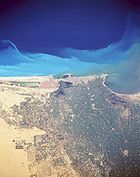 |
He was a figure in the Monophysitism Monophysitism Monophysitism , or Monophysiticism, is the Christological position that Jesus Christ has only one nature, his humanity being absorbed by his Deity... minority of Eastern Christianity. His criticism of Aristotelian physics Aristotelian physics Aristotelian Physics the natural sciences, are described in the works of the Greek philosopher Aristotle . In the Physics, Aristotle established general principles of change that govern all natural bodies; both living and inanimate, celestial and terrestrial—including all motion, change in respect... was important to Medieval science. He also theorized about the nature of light and the stars. As a theologian he rejected the Council of Chalcedon Council of Chalcedon The Council of Chalcedon was a church council held from 8 October to 1 November, 451 AD, at Chalcedon , on the Asian side of the Bosporus. The council marked a significant turning point in the Christological debates that led to the separation of the church of the Eastern Roman Empire in the 5th... and his major Christological work is Arbiter.He was also called John of Alexandria, hence the picture. |
| Bede, the Venerable Bede Bede , also referred to as Saint Bede or the Venerable Bede , was a monk at the Northumbrian monastery of Saint Peter at Monkwearmouth, today part of Sunderland, England, and of its companion monastery, Saint Paul's, in modern Jarrow , both in the Kingdom of Northumbria... (c.672–735) |
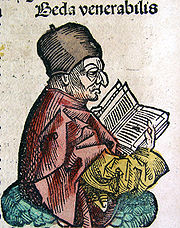 |
Catholic monk Monk A monk is a person who practices religious asceticism, living either alone or with any number of monks, while always maintaining some degree of physical separation from those not sharing the same purpose... , venerated as a saint Saint A saint is a holy person. In various religions, saints are people who are believed to have exceptional holiness.In Christian usage, "saint" refers to any believer who is "in Christ", and in whom Christ dwells, whether in heaven or in earth... and Doctor of the Church Doctor of the Church Doctor of the Church is a title given by a variety of Christian churches to individuals whom they recognize as having been of particular importance, particularly regarding their contribution to theology or doctrine.-Catholic Church:In the Catholic Church, this name is given to a saint from whose... . He was an influence for early medieval knowledge of nature. He wrote two works on "Time and its Reckoning." This primarily concerned how to date Easter, but contained a new recognition of the "progress wave-like" nature of tides. |
| Rabanus Maurus Rabanus Maurus Rabanus Maurus Magnentius , also known as Hrabanus or Rhabanus, was a Frankish Benedictine monk, the archbishop of Mainz in Germany and a theologian. He was the author of the encyclopaedia De rerum naturis . He also wrote treatises on education and grammar and commentaries on the Bible... (c.780–856) |
 |
Benedictine Benedictine Benedictine refers to the spirituality and consecrated life in accordance with the Rule of St Benedict, written by Benedict of Nursia in the sixth century for the cenobitic communities he founded in central Italy. The most notable of these is Monte Cassino, the first monastery founded by Benedict... monk and teacher, he later became archbishop of Mainz and is venerated as blessed in the Catholic Church. He wrote a treatise on Computus Computus Computus is the calculation of the date of Easter in the Christian calendar. The name has been used for this procedure since the early Middle Ages, as it was one of the most important computations of the age.... and the encyclopedic work De universo. His teaching earned him the accolade of Praeceptor Germaniae, or "the teacher of Germany." |
| Leo the Mathematician Leo the Mathematician Leo the Mathematician or the Philosopher was a Byzantine philosopher and logician associated with the Macedonian Renaissance and the end of Iconoclasm. His only preserved writings are some notes contained in manuscripts of Plato's dialogues. He has been called a "true Renaissance man" and "the... (c.790–a.869) |
_by_florentine_cartographer_cristoforo_buondelmonte.jpg) |
Archbishop Archbishop An archbishop is a bishop of higher rank, but not of higher sacramental order above that of the three orders of deacon, priest , and bishop... of Thessalonica, he later became the head of the Magnaura School Magnaura The Magnaura was a large building in Constantinople. It is equated by scholars with the building that housed the Senate, and which was located east of the Augustaion, close to the Hagia Sophia and next to the Chalke gate of the Great Palace... of philosophy in Constantinople Constantinople Constantinople was the capital of the Roman, Eastern Roman, Byzantine, Latin, and Ottoman Empires. Throughout most of the Middle Ages, Constantinople was Europe's largest and wealthiest city.-Names:... , where he taught Aristotelian logic Organon The Organon is the name given by Aristotle's followers, the Peripatetics, to the standard collection of his six works on logic:* Categories* On Interpretation* Prior Analytics* Posterior Analytics... . Leo also composed his own medical encyclopaedia. He has been called a "true Renaissance man" and "the cleverest man in Byzantium in the 9th century". |
| Hunayn ibn Ishaq Hunayn ibn Ishaq Hunayn ibn Ishaq was a famous and influential Assyrian Nestorian Christian scholar, physician, and scientist, known for his work in translating Greek scientific and medical works into Arabic and Syriac during the heyday of the Islamic Abbasid Caliphate.Ḥunayn ibn Isḥaq was the most productive... (c.809–873) |
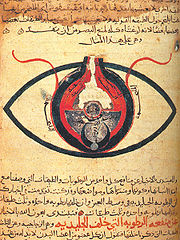 |
Assyrian Christian physician Physician A physician is a health care provider who practices the profession of medicine, which is concerned with promoting, maintaining or restoring human health through the study, diagnosis, and treatment of disease, injury and other physical and mental impairments... known for translations of Greek scientific works and as author of "Ten Treatises on Ophthalmology." The image shows a picture inspired by his anatomical descriptions of the eye. He also wrote "How to Grasp Religion", which involved the apologetics for his faith. |
1001–1200 (11th and 12th centuries)
Even by the year 1000, western EuropeWestern Europe
Western Europe is a loose term for the collection of countries in the western most region of the European continents, though this definition is context-dependent and carries cultural and political connotations. One definition describes Western Europe as a geographic entity—the region lying in the...
remained a backwater compared to other world regions: while the population in Constantinople exceeded 300,000, Rome had mere 35,000 inhabitants and Paris only 20,000. This new period, however, saw prosperity and rapidly increasing population
Medieval demography
This article discusses human demography in Europe during the Middle Ages, including population trends and movements. Demographic changes helped to shape and define the Middle Ages...
, which brought about great social and political change.
During the Renaissance of the 12th century
Renaissance of the 12th century
The Renaissance of the 12th century was a period of many changes at the outset of the High Middle Ages. It included social, political and economic transformations, and an intellectual revitalization of Western Europe with strong philosophical and scientific roots...
, interest in the study of nature was revitalized through an intense translation movement aimed at Greek and Arabic scientific texts. Monastic
Monastic school
Monastic schools were, along with cathedral schools, the most important institutions of higher learning in the Latin West from the early Middle Ages until the 12th century. Since Cassiodorus's educational program, the standard curriculum incorporated religious studies, the Trivium, and the...
and cathedral school
Cathedral school
Cathedral schools began in the Early Middle Ages as centers of advanced education, some of them ultimately evolving into medieval universities. Throughout the Middle Ages and beyond, they were complemented by the monastic schools...
s took a leading role in studying these texts and theorizing over the new insights they brought. At the same time, an important new kind of higher learning institution was being developed: the university
Medieval university
Medieval university is an institution of higher learning which was established during High Middle Ages period and is a corporation.The first institutions generally considered to be universities were established in Italy, France, and England in the late 11th and the 12th centuries for the study of...
.
| Name | Image | Reason for inclusion |
|---|---|---|
| Pope Sylvester II (c.950–1003) | Benedictine monk, scientist, teacher, and later Pope Pope The Pope is the Bishop of Rome, a position that makes him the leader of the worldwide Catholic Church . In the Catholic Church, the Pope is regarded as the successor of Saint Peter, the Apostle... ; he promoted such knowledge as mathematics Mathematics Mathematics is the study of quantity, space, structure, and change. Mathematicians seek out patterns and formulate new conjectures. Mathematicians resolve the truth or falsity of conjectures by mathematical proofs, which are arguments sufficient to convince other mathematicians of their validity... and astronomy Astronomy Astronomy is a natural science that deals with the study of celestial objects and phenomena that originate outside the atmosphere of Earth... in Europe. As professor of the cathedral school at Rheims, he raised it to the height of prosperity. He also reintroduced the abacus Abacus The abacus, also called a counting frame, is a calculating tool used primarily in parts of Asia for performing arithmetic processes. Today, abaci are often constructed as a bamboo frame with beads sliding on wires, but originally they were beans or stones moved in grooves in sand or on tablets of... and armillary sphere Armillary sphere An armillary sphere is a model of objects in the sky , consisting of a spherical framework of rings, centred on Earth, that represent lines of celestial longitude and latitude and other astronomically important features such as the ecliptic... to Europe, which had been lost to the continent since the end of the Greco-Roman era. |
|
| Hermann of Reichenau Hermann of Reichenau Hermann of Reichenau , also called Hermannus Contractus or Hermannus Augiensis or Herman the Cripple, was an 11th century scholar, composer, music theorist, mathematician, and astronomer. He composed the Marian prayer Alma Redemptoris Mater... (1013–1054) |
Crippled by a paralytic disease from early childhood, he was a Benedictine monk who composed famous Marian antiphons and was beatified. As a scientist, he wrote on topics such as geometry Geometry Geometry arose as the field of knowledge dealing with spatial relationships. Geometry was one of the two fields of pre-modern mathematics, the other being the study of numbers .... , mathematics, and the astrolabe Astrolabe An astrolabe is an elaborate inclinometer, historically used by astronomers, navigators, and astrologers. Its many uses include locating and predicting the positions of the Sun, Moon, planets, and stars, determining local time given local latitude and longitude, surveying, triangulation, and to... (pictured). |
|
| Hugh of Saint Victor(c.1096–1141) | Influential mystic and philosopher who embraced science as a tool for approaching God. He was master of the monastic school of Saint Victor. His work presents knowledge of reality as redemptive Redemption (theology) Redemption is a concept common to several theologies. It is generally associated with the efforts of people within a faith to overcome their shortcomings and achieve the moral positions exemplified in their faith.- In Buddhism :... of fallen man Original sin Original sin is, according to a Christian theological doctrine, humanity's state of sin resulting from the Fall of Man. This condition has been characterized in many ways, ranging from something as insignificant as a slight deficiency, or a tendency toward sin yet without collective guilt, referred... ; and technology Technology Technology is the making, usage, and knowledge of tools, machines, techniques, crafts, systems or methods of organization in order to solve a problem or perform a specific function. It can also refer to the collection of such tools, machinery, and procedures. The word technology comes ;... as source of physical relief and able to help reunite man with divine wisdom. "Learn everything," he urged; "later you will see that nothing is superfluous." |
|
| William of Conches William of Conches William of Conches was a French scholastic philosopher who sought to expand the bounds of Christian humanism by studying secular works of the classics and fostering empirical science. He was a prominent member of the School of Chartres... (c.1090–a.1154) |
Scholastic Scholasticism Scholasticism is a method of critical thought which dominated teaching by the academics of medieval universities in Europe from about 1100–1500, and a program of employing that method in articulating and defending orthodoxy in an increasingly pluralistic context... philosopher who sought to expand Christian humanism Christian humanism Christian humanism is the position that universal human dignity and individual freedom are essential and principal components of, or are at least compatible with, Christian doctrine and practice. It is a philosophical union of Christian and humanist principles.- Origins :Christian humanism may have... by studying secular works of the classics and fostering empirical science. He held an atomistic Atomism Atomism is a natural philosophy that developed in several ancient traditions. The atomists theorized that the natural world consists of two fundamental parts: indivisible atoms and empty void.According to Aristotle, atoms are indestructible and immutable and there are an infinite variety of shapes... explanation of nature, and his hexameron Hexameron The term Hexameron refers either to the genre of theological treatise that describes God's work on the six days of creation or to the six days of creation themselves. Most often these theological works take the form of commentaries on Genesis 1... is a notable example of the naturalism Naturalism (philosophy) Naturalism commonly refers to the philosophical viewpoint that the natural universe and its natural laws and forces operate in the universe, and that nothing exists beyond the natural universe or, if it does, it does not affect the natural universe that we know... that came to characterize later medieval accounts of the six days of creation. He was a leading member of the cathedral school at Chartres School of Chartres During the High Middle Ages, Chartres Cathedral operated a famous and influential cathedral school, an important center of scholarship. It developed and reached its apex in the 11th and 12th centuries... . |
|
| Hildegard of Bingen Hildegard of Bingen Blessed Hildegard of Bingen , also known as Saint Hildegard, and Sibyl of the Rhine, was a German writer, composer, philosopher, Christian mystic, Benedictine abbess, visionary, and polymath. Elected a magistra by her fellow nuns in 1136, she founded the monasteries of Rupertsberg in 1150 and... (1098–1179) |
Benedictine abbess Abbess An abbess is the female superior, or mother superior, of a community of nuns, often an abbey.... , writer, composer, philosopher, mystic, visionary Visionary Defined broadly, a visionary, is one who can envision the future. For some groups this can involve the supernatural or drugs.The visionary state is achieved via meditation, drugs, lucid dreams, daydreams, or art. One example is Hildegard of Bingen, a 12th century artist/visionary and Catholic saint... , polymath Polymath A polymath is a person whose expertise spans a significant number of different subject areas. In less formal terms, a polymath may simply be someone who is very knowledgeable... and Germany's first female physician Physician A physician is a health care provider who practices the profession of medicine, which is concerned with promoting, maintaining or restoring human health through the study, diagnosis, and treatment of disease, injury and other physical and mental impairments... . She conducted and published comprehensive studies of natural science and medicine. Hildegard was well known in her own century as "the female prophet" and is venerated as a Catholic saint. |
1201–1400 (13th and 14th centuries)
The translation of scientific texts continued. By 1200, there were reasonably accurate Latin versions of the main classical works. Meanwhile, the new universitiesMedieval university
Medieval university is an institution of higher learning which was established during High Middle Ages period and is a corporation.The first institutions generally considered to be universities were established in Italy, France, and England in the late 11th and the 12th centuries for the study of...
were rapidly spreading through Europe and providing a new infrastructure for scientific communities
Scientific community
The scientific community consists of the total body of scientists, its relationships and interactions. It is normally divided into "sub-communities" each working on a particular field within science. Objectivity is expected to be achieved by the scientific method...
. They became the main institutions in which the new texts were studied and elaborated. In fact, the medieval university curriculum
Curriculum
See also Syllabus.In formal education, a curriculum is the set of courses, and their content, offered at a school or university. As an idea, curriculum stems from the Latin word for race course, referring to the course of deeds and experiences through which children grow to become mature adults...
laid much more emphasis on scientific knowledge than does its modern descendent. This all lead to innovative scientific work being done, especially in the 14th century.
| Name | Image | Reason for inclusion |
|---|---|---|
| Robert Grosseteste Robert Grosseteste Robert Grosseteste or Grossetete was an English statesman, scholastic philosopher, theologian and Bishop of Lincoln. He was born of humble parents at Stradbroke in Suffolk. A.C... (c.1175–1253) |
Bishop of Lincoln Bishop of Lincoln The Bishop of Lincoln is the Ordinary of the Church of England Diocese of Lincoln in the Province of Canterbury.The present diocese covers the county of Lincolnshire and the unitary authority areas of North Lincolnshire and North East Lincolnshire. The Bishop's seat is located in the Cathedral... , he was the central character of the English intellectual movement in the first half of the 13th century and is considered the founder of scientific thought in Oxford Oxford The city of Oxford is the county town of Oxfordshire, England. The city, made prominent by its medieval university, has a population of just under 165,000, with 153,900 living within the district boundary. It lies about 50 miles north-west of London. The rivers Cherwell and Thames run through... . He had a great interest in the natural world and wrote texts on the mathematical sciences of optics Optics Optics is the branch of physics which involves the behavior and properties of light, including its interactions with matter and the construction of instruments that use or detect it. Optics usually describes the behavior of visible, ultraviolet, and infrared light... , astronomy Astronomy Astronomy is a natural science that deals with the study of celestial objects and phenomena that originate outside the atmosphere of Earth... and geometry Geometry Geometry arose as the field of knowledge dealing with spatial relationships. Geometry was one of the two fields of pre-modern mathematics, the other being the study of numbers .... . He affirmed that experiments should be used in order to verify a theory, testing its consequences. |
|
| Pope John XXI Pope John XXI Pope John XXI, , born Pedro Julião Pope John XXI, , born Pedro Julião Pope John XXI, , born Pedro Julião (Latin, Petrus Iulianus (c. 1215 – May 20, 1277), a Portuguese also called Pedro Hispano (Latin, Petrus Hispanus; English, Peter of Spain), was Pope from 1276 until his death about eight... (c.1215–1277) |
He wrote the widely used medical text Thesaurus pauperum before becoming Pope. When he took office as pope in 1277, he immediately cracked down on heterodoxy including Averroes Averroes ' , better known just as Ibn Rushd , and in European literature as Averroes , was a Muslim polymath; a master of Aristotelian philosophy, Islamic philosophy, Islamic theology, Maliki law and jurisprudence, logic, psychology, politics, Arabic music theory, and the sciences of medicine, astronomy,... works and teachings on Aristotle. |
|
| Albertus Magnus Albertus Magnus Albertus Magnus, O.P. , also known as Albert the Great and Albert of Cologne, is a Catholic saint. He was a German Dominican friar and a bishop, who achieved fame for his comprehensive knowledge of and advocacy for the peaceful coexistence of science and religion. Those such as James A. Weisheipl... (c.1193–1280) |
Patron saint Patron saint A patron saint is a saint who is regarded as the intercessor and advocate in heaven of a nation, place, craft, activity, class, clan, family, or person... of scientists in Catholicism who may have been the first to isolate arsenic Arsenic Arsenic is a chemical element with the symbol As, atomic number 33 and relative atomic mass 74.92. Arsenic occurs in many minerals, usually in conjunction with sulfur and metals, and also as a pure elemental crystal. It was first documented by Albertus Magnus in 1250.Arsenic is a metalloid... . He wrote that: "Natural science does not consist in ratifying what others have said, but in seeking the causes of phenomena." Yet he rejected elements of Aristotelianism that conflicted with Catholicism and drew on his faith as well as Neo-Platonic ideas to "balance" "troubling" Aristotelian elements.In 1252 he helped appoint Thomas Aquinas to a Dominican theological chair in Paris to lead the suppression of these dangerous ideas. |
|
| Roger Bacon Roger Bacon Roger Bacon, O.F.M. , also known as Doctor Mirabilis , was an English philosopher and Franciscan friar who placed considerable emphasis on the study of nature through empirical methods... (c.1214–1294) |
He was an English philosopher who emphasized empiricism Empiricism Empiricism is a theory of knowledge that asserts that knowledge comes only or primarily via sensory experience. One of several views of epistemology, the study of human knowledge, along with rationalism, idealism and historicism, empiricism emphasizes the role of experience and evidence,... and has been presented as one of the earliest advocates of the modern scientific method Scientific method Scientific method refers to a body of techniques for investigating phenomena, acquiring new knowledge, or correcting and integrating previous knowledge. To be termed scientific, a method of inquiry must be based on gathering empirical and measurable evidence subject to specific principles of... . He joined the Franciscan Order around 1240, where he was influenced by Grosseteste. Bacon was responsible for making the concept of "laws of nature" widespread, and contributed in such areas as mechanics Mechanics Mechanics is the branch of physics concerned with the behavior of physical bodies when subjected to forces or displacements, and the subsequent effects of the bodies on their environment.... , geography Geography Geography is the science that studies the lands, features, inhabitants, and phenomena of Earth. A literal translation would be "to describe or write about the Earth". The first person to use the word "geography" was Eratosthenes... and, most of all, optics. It is said that he was imprisoned by the church for many years because of his scientific teachings, although this is disputed. |
|
| Theodoric of Freiberg Theodoric of Freiberg Theodoric of Freiberg was a German member of the Dominican order and a theologian and physicist... (c.1250–c.1310) |
Dominican Dominican Order The Order of Preachers , after the 15th century more commonly known as the Dominican Order or Dominicans, is a Catholic religious order founded by Saint Dominic and approved by Pope Honorius III on 22 December 1216 in France... who is believed to have given the first correct explanation for the rainbow in De iride et radialibus impressionibus or On the Rainbow. In theology he disagreed with Thomas Aquinas Thomas Aquinas Thomas Aquinas, O.P. , also Thomas of Aquin or Aquino, was an Italian Dominican priest of the Catholic Church, and an immensely influential philosopher and theologian in the tradition of scholasticism, known as Doctor Angelicus, Doctor Communis, or Doctor Universalis... on metaphysical positions and tended towards a more Neoplatonic outlook than Aquinas. |
|
| Thomas Bradwardine Thomas Bradwardine Thomas Bradwardine was an English scholar, scientist, courtier and, very briefly, Archbishop of Canterbury. As a celebrated scholastic philosopher and doctor of theology, he is often called Doctor Profundus, .-Life:He was born either at Hartfield in Sussex or at Chichester, where his family were... (c.1290–1349) |
He was an English archbishop Archbishop An archbishop is a bishop of higher rank, but not of higher sacramental order above that of the three orders of deacon, priest , and bishop... , often called "the Profound Doctor". He developed studies as one of the Oxford Calculators Oxford Calculators The Oxford Calculators were a group of 14th-century thinkers, almost all associated with Merton College, Oxford, who took a strikingly logico-mathematical approach to philosophical problems.... of Merton College, Oxford University. These studies would lead to important developments in mechanics Mechanics Mechanics is the branch of physics concerned with the behavior of physical bodies when subjected to forces or displacements, and the subsequent effects of the bodies on their environment.... . |
|
| William of Ockham William of Ockham William of Ockham was an English Franciscan friar and scholastic philosopher, who is believed to have been born in Ockham, a small village in Surrey. He is considered to be one of the major figures of medieval thought and was at the centre of the major intellectual and political controversies of... (c.1285–c.1350) |
He was an English England England is a country that is part of the United Kingdom. It shares land borders with Scotland to the north and Wales to the west; the Irish Sea is to the north west, the Celtic Sea to the south west, with the North Sea to the east and the English Channel to the south separating it from continental... Franciscan Franciscan Most Franciscans are members of Roman Catholic religious orders founded by Saint Francis of Assisi. Besides Roman Catholic communities, there are also Old Catholic, Anglican, Lutheran, ecumenical and Non-denominational Franciscan communities.... friar Friar A friar is a member of one of the mendicant orders.-Friars and monks:... and scholastic Scholasticism Scholasticism is a method of critical thought which dominated teaching by the academics of medieval universities in Europe from about 1100–1500, and a program of employing that method in articulating and defending orthodoxy in an increasingly pluralistic context... philosopher. He is a major figure of medieval thought and was at the center of the major intellectual and political controversies of his time. Commonly known for Occam's razor Occam's razor Occam's razor, also known as Ockham's razor, and sometimes expressed in Latin as lex parsimoniae , is a principle that generally recommends from among competing hypotheses selecting the one that makes the fewest new assumptions.-Overview:The principle is often summarized as "simpler explanations... , the scientific/methodological principle that bears his name, he also produced significant works on logic Logic In philosophy, Logic is the formal systematic study of the principles of valid inference and correct reasoning. Logic is used in most intellectual activities, but is studied primarily in the disciplines of philosophy, mathematics, semantics, and computer science... , physics Physics Physics is a natural science that involves the study of matter and its motion through spacetime, along with related concepts such as energy and force. More broadly, it is the general analysis of nature, conducted in order to understand how the universe behaves.Physics is one of the oldest academic... , and theology Theology Theology is the systematic and rational study of religion and its influences and of the nature of religious truths, or the learned profession acquired by completing specialized training in religious studies, usually at a university or school of divinity or seminary.-Definition:Augustine of Hippo... . |
|
| Jean Buridan Jean Buridan Jean Buridan was a French priest who sowed the seeds of the Copernican revolution in Europe. Although he was one of the most famous and influential philosophers of the late Middle Ages, he is today among the least well known... (c.1300–c.1358) |
He was a Catholic priest and one of the most influential philosophers of the later Middle Ages Middle Ages The Middle Ages is a periodization of European history from the 5th century to the 15th century. The Middle Ages follows the fall of the Western Roman Empire in 476 and precedes the Early Modern Era. It is the middle period of a three-period division of Western history: Classic, Medieval and Modern... . He developed the theory of impetus Impetus Impetus may refer to:* Impetus , a re-release of the EP Passive Restraints* Impetus , a concept very similar to momentum* Jean Buridan#Impetus Theory, middle-ages treatment on impetus and its originator Jean Buridan... , which was an important step toward the modern concept of inertia Inertia Inertia is the resistance of any physical object to a change in its state of motion or rest, or the tendency of an object to resist any change in its motion. It is proportional to an object's mass. The principle of inertia is one of the fundamental principles of classical physics which are used to... . |
|
| Nicole Oresme (c.1323–1382) |  |
Theologian and bishop of Lisieux, he was one of the early founders and popularizers of modern sciences. One of his many scientific contributions is the discovery of the curvature of light through atmospheric refraction Refraction Refraction is the change in direction of a wave due to a change in its speed. It is essentially a surface phenomenon . The phenomenon is mainly in governance to the law of conservation of energy. The proper explanation would be that due to change of medium, the phase velocity of the wave is changed... . |
1401–1600 (15th and 16th centuries)
Around 1350, the Black DeathBlack Death
The Black Death was one of the most devastating pandemics in human history, peaking in Europe between 1348 and 1350. Of several competing theories, the dominant explanation for the Black Death is the plague theory, which attributes the outbreak to the bacterium Yersinia pestis. Thought to have...
and other disasters
Crisis of the Late Middle Ages
The Crisis of the Late Middle Ages refers to a series of events in the fourteenth and fifteenth centuries that brought centuries of European prosperity and growth to a halt...
sealed a sudden end to the previous period of massive philosophic and scientific development. Even during the initial portion of the Renaissance
Renaissance
The Renaissance was a cultural movement that spanned roughly the 14th to the 17th century, beginning in Italy in the Late Middle Ages and later spreading to the rest of Europe. The term is also used more loosely to refer to the historical era, but since the changes of the Renaissance were not...
, the amount of scientific activity remained depressed.
Yet, developments such as the printing press
Printing press
A printing press is a device for applying pressure to an inked surface resting upon a print medium , thereby transferring the ink...
and the dissemination of algebra
Algebra
Algebra is the branch of mathematics concerning the study of the rules of operations and relations, and the constructions and concepts arising from them, including terms, polynomials, equations and algebraic structures...
would soon have important consequences. From around 1475 scientific inquiry resumed and later reached levels previously unseen. It was a period of great upheaval: the Fall of Constantinople
Fall of Constantinople
The Fall of Constantinople was the capture of the capital of the Byzantine Empire, which occurred after a siege by the Ottoman Empire, under the command of Ottoman Sultan Mehmed II, against the defending army commanded by Byzantine Emperor Constantine XI...
; the discovery of the Americas; the Protestant Reformation
Protestant Reformation
The Protestant Reformation was a 16th-century split within Western Christianity initiated by Martin Luther, John Calvin and other early Protestants. The efforts of the self-described "reformers", who objected to the doctrines, rituals and ecclesiastical structure of the Roman Catholic Church, led...
and the Catholic Counter-Reformation
Counter-Reformation
The Counter-Reformation was the period of Catholic revival beginning with the Council of Trent and ending at the close of the Thirty Years' War, 1648 as a response to the Protestant Reformation.The Counter-Reformation was a comprehensive effort, composed of four major elements:#Ecclesiastical or...
presaged large social and political changes. Indeed, the publication of Copernicus' heliocentric model of the cosmos (1543) is seen by many as marking the beginning of a scientific revolution
Scientific revolution
The Scientific Revolution is an era associated primarily with the 16th and 17th centuries during which new ideas and knowledge in physics, astronomy, biology, medicine and chemistry transformed medieval and ancient views of nature and laid the foundations for modern science...
.
| Name | Image | Reason for inclusion |
|---|---|---|
| Nicholas of Cusa (1401–1464) | 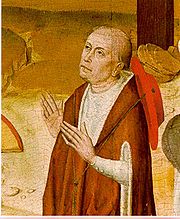 |
Catholic cardinal Cardinal (Catholicism) A cardinal is a senior ecclesiastical official, usually an ordained bishop, and ecclesiastical prince of the Catholic Church. They are collectively known as the College of Cardinals, which as a body elects a new pope. The duties of the cardinals include attending the meetings of the College and... and theologian who made contributions to the field of mathematics by developing the concepts of the infinitesimal and of relative motion. His philosophical speculations also anticipated Copernicus Nicolaus Copernicus Nicolaus Copernicus was a Renaissance astronomer and the first person to formulate a comprehensive heliocentric cosmology which displaced the Earth from the center of the universe.... ’ heliocentric Heliocentrism Heliocentrism, or heliocentricism, is the astronomical model in which the Earth and planets revolve around a stationary Sun at the center of the universe. The word comes from the Greek . Historically, heliocentrism was opposed to geocentrism, which placed the Earth at the center... world-view. |
| Otto Brunfels Otto Brunfels Otto Brunfels was a German theologian and botanist... (1488–1534) |
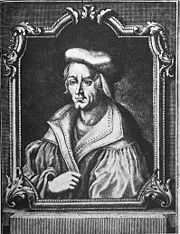 |
A theologian and botanist from Mainz Mainz Mainz under the Holy Roman Empire, and previously was a Roman fort city which commanded the west bank of the Rhine and formed part of the northernmost frontier of the Roman Empire... , Germany. His Catalogi virorum illustrium is considered to be the first book on the history of evangelical sects that had broken away from the Catholic Church. In botany his Herbarum vivae icones helped earn him acclaim as one of the "fathers of botany". |
| Nicolaus Copernicus Nicolaus Copernicus Nicolaus Copernicus was a Renaissance astronomer and the first person to formulate a comprehensive heliocentric cosmology which displaced the Earth from the center of the universe.... (1473–1543) |
 |
Catholic canon Canon (priest) A canon is a priest or minister who is a member of certain bodies of the Christian clergy subject to an ecclesiastical rule .... who introduced a heliocentric world view. In 1616, in connection with the Galileo affair Galileo affair The Galileo affair was a sequence of events, beginning around 1610, during which Galileo Galilei came into conflict with the Aristotelian scientific view of the universe , over his support of Copernican astronomy.... , this work was forbidden by the Church "until corrected". Nine sentences representing heliocentricism as certain had to be either omitted or changed. This done, the reading of the book was allowed. Only in 1835 the original uncensored version was dropped from the Index of Prohibited Books Index Librorum Prohibitorum The Index Librorum Prohibitorum was a list of publications prohibited by the Catholic Church. A first version was promulgated by Pope Paul IV in 1559, and a revised and somewhat relaxed form was authorized at the Council of Trent... . |
| Michael Servetus Michael Servetus Michael Servetus was a Spanish theologian, physician, cartographer, and humanist. He was the first European to correctly describe the function of pulmonary circulation... (1511–1553) |
 |
Nontrinitarian who was condemned and imprisoned by Catholics before being burned at the stake by Calvinists in Protestant-run Geneva. In science wrote on astronomy and his theological work "Christianismi Restitutio" contained the first European description of the function of pulmonary circulation Pulmonary circulation Pulmonary circulation is the half portion of the cardiovascular system which carries Oxygen-depleted Blood away from the heart, to the Lungs, and returns oxygenated blood back to the heart. Encyclopedic description and discovery of the pulmonary circulation is widely attributed to Doctor Ibn... . |
| Michael Stifel Michael Stifel Michael Stifel or Styfel was a German monk and mathematician. He was an Augustinian who became an early supporter of Martin Luther. Stifel was later appointed professor of mathematics at Jena University... (c.1486–1567) |
Augustinian monk and mathematician who became an early supporter of Martin Luther Martin Luther Martin Luther was a German priest, professor of theology and iconic figure of the Protestant Reformation. He strongly disputed the claim that freedom from God's punishment for sin could be purchased with money. He confronted indulgence salesman Johann Tetzel with his Ninety-Five Theses in 1517... . His Arithmetica integra (pictured) contained important innovations in mathematical notation and a table of integers and powers of 2 that some have considered to be an early version of a logarithm Logarithm The logarithm of a number is the exponent by which another fixed value, the base, has to be raised to produce that number. For example, the logarithm of 1000 to base 10 is 3, because 1000 is 10 to the power 3: More generally, if x = by, then y is the logarithm of x to base b, and is written... ic table. He also wrote on Biblical prophecies. |
|
| William Turner (c.1508–1568) | He is sometimes called the "father of English botany" and was also an ornithologist. Religiously he was arrested for preaching in favor of the Reformation. He later became a Dean of Wells Cathedral Wells Cathedral Wells Cathedral is a Church of England cathedral in Wells, Somerset, England. It is the seat of the Bishop of Bath and Wells, who lives at the adjacent Bishop's Palace.... , pictured, but was expelled for nonconformity. |
|
| Ignazio Danti Ignazio Danti Ignazio Danti , born Pellegrino Rainaldi Danti, was an Italian priest, mathematician, astronomer, and cosmographer.-Biography:Danti was born in Perugia to a family rich in artists and scientists... (1536–1586) |
As bishop of Alatri he convoked a diocesan synod to deal with abuses. He was also a mathematician who wrote on Euclid Euclid Euclid , fl. 300 BC, also known as Euclid of Alexandria, was a Greek mathematician, often referred to as the "Father of Geometry". He was active in Alexandria during the reign of Ptolemy I... , an astronomer, and a designer of mechanical devices. |
|
| Giordano Bruno Giordano Bruno Giordano Bruno , born Filippo Bruno, was an Italian Dominican friar, philosopher, mathematician and astronomer. His cosmological theories went beyond the Copernican model in proposing that the Sun was essentially a star, and moreover, that the universe contained an infinite number of inhabited... (1548–1600) |
 |
Italian philosopher, priest, cosmologist, and occultist, known for espousing the idea the that Earth revolves around the Sun and that many other worlds revolve around other suns. For his many heretical views, including his denial of the divinity of Christ, he was tried by the Roman Inquisition and burned at the stake. The Catholic Encyclopedia labels his system of beliefs "an incoherent materialistic pantheism." |
1601–1700 (17th century)
If the scientific revolutionScientific revolution
The Scientific Revolution is an era associated primarily with the 16th and 17th centuries during which new ideas and knowledge in physics, astronomy, biology, medicine and chemistry transformed medieval and ancient views of nature and laid the foundations for modern science...
started in the 16th century, it was now in full operation. New ideas in physics, astronomy, biology, human anatomy, chemistry, and other sciences were posing a challenge for many conceptions about nature that had prevailed starting in Ancient Greece
Ancient Greece
Ancient Greece is a civilization belonging to a period of Greek history that lasted from the Archaic period of the 8th to 6th centuries BC to the end of antiquity. Immediately following this period was the beginning of the Early Middle Ages and the Byzantine era. Included in Ancient Greece is the...
and continuing through the Middle Ages
Middle Ages
The Middle Ages is a periodization of European history from the 5th century to the 15th century. The Middle Ages follows the fall of the Western Roman Empire in 476 and precedes the Early Modern Era. It is the middle period of a three-period division of Western history: Classic, Medieval and Modern...
. This eventually led to the rejection of the old views and established a new framework for the study of nature. The period culminated with the publication of the Philosophiæ Naturalis Principia Mathematica in 1687 by Isaac Newton
Isaac Newton
Sir Isaac Newton PRS was an English physicist, mathematician, astronomer, natural philosopher, alchemist, and theologian, who has been "considered by many to be the greatest and most influential scientist who ever lived."...
, representative of the unprecedented growth of scientific publications
Antiquarian science book
Antiquarian science books are original works that are at least roughly 100 years old, concerning science, mathematics and sometimes engineering...
throughout Europe. Newton is presented in the next section of the list, since he died in 1720.
| Name | Image | Reason for inclusion |
|---|---|---|
| Bartholomaeus Pitiscus Bartholomaeus Pitiscus Bartholomaeus Pitiscus was a 16th century German trigonometrist, astronomer and theologian who first coined the word Trigonometry.... (1561–1613) |
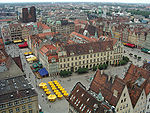 |
He may have introduced the word trigonometry into English and French. He was also a Calvinist theologian who acted as court preacher at the town then called Breslau, hence the image of their town square. |
| John Napier John Napier John Napier of Merchiston – also signed as Neper, Nepair – named Marvellous Merchiston, was a Scottish mathematician, physicist, astronomer & astrologer, and also the 8th Laird of Merchistoun. He was the son of Sir Archibald Napier of Merchiston. John Napier is most renowned as the discoverer... (1550–1617) |
 |
Scottish mathematician known for inventing logarithm Logarithm The logarithm of a number is the exponent by which another fixed value, the base, has to be raised to produce that number. For example, the logarithm of 1000 to base 10 is 3, because 1000 is 10 to the power 3: More generally, if x = by, then y is the logarithm of x to base b, and is written... s, Napier's bones Napier's bones Napier's bones is an abacus created by John Napier for calculation of products and quotients of numbers that was based on Arab mathematics and lattice multiplication used by Matrakci Nasuh in the Umdet-ul Hisab and Fibonacci writing in the Liber Abaci. Also called Rabdology... , and being the popularizer of the use of decimals. He also was a staunch Protestant who wrote on the Book of Revelation Book of Revelation The Book of Revelation is the final book of the New Testament. The title came into usage from the first word of the book in Koine Greek: apokalupsis, meaning "unveiling" or "revelation"... . |
| Johannes Kepler Johannes Kepler Johannes Kepler was a German mathematician, astronomer and astrologer. A key figure in the 17th century scientific revolution, he is best known for his eponymous laws of planetary motion, codified by later astronomers, based on his works Astronomia nova, Harmonices Mundi, and Epitome of Copernican... (1571–1630) |
 |
His model of the cosmos based on nesting Platonic solids was explicitly driven by religious ideas; his later and most famous scientific contribution, the Kepler's laws of planetary motion Kepler's laws of planetary motion In astronomy, Kepler's laws give a description of the motion of planets around the Sun.Kepler's laws are:#The orbit of every planet is an ellipse with the Sun at one of the two foci.... , was based on empirical data that he obtained from Tycho Brahe Tycho Brahe Tycho Brahe , born Tyge Ottesen Brahe, was a Danish nobleman known for his accurate and comprehensive astronomical and planetary observations... 's meticulous astronomical observations, after Tycho died of mercury poisoning. He had wanted to be a theologian at one time and his Harmonice Mundi Harmonice Mundi Harmonices Mundi is a book by Johannes Kepler. In the work Kepler discusses harmony and congruence in geometrical forms and physical phenomena... discusses Christ at points. |
| Galileo Galilei Galileo Galilei Galileo Galilei , was an Italian physicist, mathematician, astronomer, and philosopher who played a major role in the Scientific Revolution. His achievements include improvements to the telescope and consequent astronomical observations and support for Copernicanism... (1564–1642) |
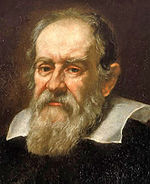 |
Scientist who had many problems with the Inquisition Inquisition The Inquisition, Inquisitio Haereticae Pravitatis , was the "fight against heretics" by several institutions within the justice-system of the Roman Catholic Church. It started in the 12th century, with the introduction of torture in the persecution of heresy... for defending heliocentrism Heliocentrism Heliocentrism, or heliocentricism, is the astronomical model in which the Earth and planets revolve around a stationary Sun at the center of the universe. The word comes from the Greek . Historically, heliocentrism was opposed to geocentrism, which placed the Earth at the center... in the convoluted period brought about by the Reformation Protestant Reformation The Protestant Reformation was a 16th-century split within Western Christianity initiated by Martin Luther, John Calvin and other early Protestants. The efforts of the self-described "reformers", who objected to the doctrines, rituals and ecclesiastical structure of the Roman Catholic Church, led... and Counter-Reformation Counter-Reformation The Counter-Reformation was the period of Catholic revival beginning with the Council of Trent and ending at the close of the Thirty Years' War, 1648 as a response to the Protestant Reformation.The Counter-Reformation was a comprehensive effort, composed of four major elements:#Ecclesiastical or... . In regard to Scripture, he took Augustine's Augustine of Hippo Augustine of Hippo , also known as Augustine, St. Augustine, St. Austin, St. Augoustinos, Blessed Augustine, or St. Augustine the Blessed, was Bishop of Hippo Regius . He was a Latin-speaking philosopher and theologian who lived in the Roman Africa Province... position: not to take every passage too literally, particularly when the scripture in question is a book of poetry and songs, not a book of instructions or history. |
| Laurentius Gothus Laurentius Paulinus Gothus Laurentius Paulinus Gothus was a Swedish theologian, astronomer and Archbishop of Uppsala .-Life:In 1588 Gothus travelled to Germany and studied in the Rostock University for three years... (1565–1646) |
 |
A professor of astronomy and Archbishop of Uppsala Archbishop of Uppsala The Archbishop of Uppsala has been the primate in Sweden in an unbroken succession since 1164, first during the Catholic era, and from the 1530s and onward under the Lutheran church.- Historical overview :... . He wrote on astronomy and theology. |
| Marin Mersenne Marin Mersenne Marin Mersenne, Marin Mersennus or le Père Mersenne was a French theologian, philosopher, mathematician and music theorist, often referred to as the "father of acoustics"... (1588–1648) |
For four years he devoted himself to theology writing Quaestiones celeberrimae in Genesim (1623) and L'Impieté des déistes (1624). These were theological essays against atheism and deism. He is more remembered for the work he did corresponding with mathematicians and concerning Mersenne prime Mersenne prime In mathematics, a Mersenne number, named after Marin Mersenne , is a positive integer that is one less than a power of two: M_p=2^p-1.\,... s. |
|
| René Descartes René Descartes René Descartes ; was a French philosopher and writer who spent most of his adult life in the Dutch Republic. He has been dubbed the 'Father of Modern Philosophy', and much subsequent Western philosophy is a response to his writings, which are studied closely to this day... (1596–1650) |
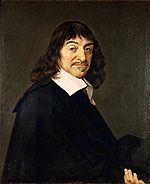 |
He was a key thinker of the Scientific Revolution. He is also honoured by having the Cartesian coordinate system used in plane geometry and algebra named after him. He did important work on invariants and geometry Geometry Geometry arose as the field of knowledge dealing with spatial relationships. Geometry was one of the two fields of pre-modern mathematics, the other being the study of numbers .... . His Meditations on First Philosophy partially concerns theology and he was devoted to reconciling his ideas with the dogmas of Catholic Faith to which he was loyal.This attempt was, and is, considered unsuccessful by the Catholic Church so his philosophy is still considered erroneous in it. |
| Pierre Gassendi Pierre Gassendi Pierre Gassendi was a French philosopher, priest, scientist, astronomer, and mathematician. With a church position in south-east France, he also spent much time in Paris, where he was a leader of a group of free-thinking intellectuals. He was also an active observational scientist, publishing the... (1592–1655) |
Catholic priest who tried to reconcile Atomism Atomism Atomism is a natural philosophy that developed in several ancient traditions. The atomists theorized that the natural world consists of two fundamental parts: indivisible atoms and empty void.According to Aristotle, atoms are indestructible and immutable and there are an infinite variety of shapes... with Christianity. He also published the first work on the Transit of Mercury Transit of Mercury A transit of Mercury across the Sun takes place when the planet Mercury comes between the Sun and the Earth, and Mercury is seen as a small black dot moving across the face of the Sun.... and corrected the geographical coordinates of the Mediterranean Sea. |
|
| Anton Maria of Rheita Anton Maria Schyrleus of Rheita Anton Maria Schyrleus of Rheita was an astronomer and optician. He developed several inverting and erecting eyepieces, and was the maker of Kepler’s telescope... (1597–1660) |
Capuchin Order of Friars Minor Capuchin The Order of Friars Minor Capuchin is an Order of friars in the Catholic Church, among the chief offshoots of the Franciscans. The worldwide head of the Order, called the Minister General, is currently Father Mauro Jöhri.-Origins :... astronomer. He dedicated one of his astronomy books to Jesus Christ, a "theo-astronomy" work was dedicated to the Blessed Virgin Mary, and he wondered if beings on other planets were "cursed by original sin Original sin Original sin is, according to a Christian theological doctrine, humanity's state of sin resulting from the Fall of Man. This condition has been characterized in many ways, ranging from something as insignificant as a slight deficiency, or a tendency toward sin yet without collective guilt, referred... like humans are." |
|
| Blaise Pascal Blaise Pascal Blaise Pascal , was a French mathematician, physicist, inventor, writer and Catholic philosopher. He was a child prodigy who was educated by his father, a tax collector in Rouen... (1623–1662) |
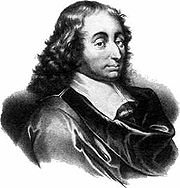 |
Jansenist Jansenism Jansenism was a Christian theological movement, primarily in France, that emphasized original sin, human depravity, the necessity of divine grace, and predestination. The movement originated from the posthumously published work of the Dutch theologian Cornelius Otto Jansen, who died in 1638... thinker;Although Jansenism was a movement within Roman Catholicism, it was generally opposed by the Catholic hierarchy and was eventually condemned as heretical. well known for Pascal's law Pascal's law In the physical sciences, Pascal's law or the Principle of transmission of fluid-pressure states that "pressure exerted anywhere in a confined incompressible fluid is transmitted equally in all directions throughout the fluid such that the pressure ratio remains the same." The law was established... (physics), Pascal's theorem Pascal's theorem In projective geometry, Pascal's theorem states that if an arbitrary hexagon is inscribed in any conic section, and pairs of opposite sides are extended until they meet, the three intersection points will lie on a straight line, the Pascal line of that configuration.- Related results :This theorem... (math), and Pascal's Wager Pascal's Wager Pascal's Wager, also known as Pascal's Gambit, is a suggestion posed by the French philosopher, mathematician, and physicist Blaise Pascal that even if the existence of God could not be determined through reason, a rational person should wager as though God exists, because one living life... (theology). |
| Isaac Barrow Isaac Barrow Isaac Barrow was an English Christian theologian, and mathematician who is generally given credit for his early role in the development of infinitesimal calculus; in particular, for the discovery of the fundamental theorem of calculus. His work centered on the properties of the tangent; Barrow was... (1630–1677) |
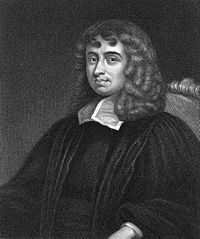 |
English divine, scientist, and mathematician. He wrote Expositions of the Creed, The Lord's Prayer, Decalogue, and Sacraments and Lectiones Opticae et Geometricae. |
| Juan Lobkowitz Juan Caramuel y Lobkowitz Juan Caramuel y Lobkowitz was a Spanish Catholic scholastic philosopher, ecclesiastic, mathematician and writer.-Life:... (1606–1682) |
Cistercian monk who did work on Combinatorics Combinatorics Combinatorics is a branch of mathematics concerning the study of finite or countable discrete structures. Aspects of combinatorics include counting the structures of a given kind and size , deciding when certain criteria can be met, and constructing and analyzing objects meeting the criteria ,... and published astronomy tables at age 10. He also did works of theology and sermons. |
|
| Nicolas Steno Nicolas Steno Nicolas Steno |Latinized]] to Nicolaus Steno -gen. Nicolai Stenonis-, Italian Niccolo' Stenone) was a Danish pioneer in both anatomy and geology. Already in 1659 he decided not to accept anything simply written in a book, instead resolving to do research himself. He is considered the father of... (1638–1686) |
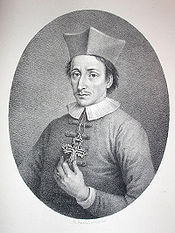 |
Lutheran convert to Catholicism, his beatification Beatification Beatification is a recognition accorded by the Catholic Church of a dead person's entrance into Heaven and capacity to intercede on behalf of individuals who pray in his or her name . Beatification is the third of the four steps in the canonization process... in that faith occurred in 1987. As a scientist he is considered a pioneer in both anatomy and geology, but largely abandoned science after his religious conversion. |
| Seth Ward Seth Ward (bishop) Seth Ward was an English mathematician, astronomer, and bishop.-Early life:He was born in Hertfordshire, and educated at Sidney Sussex College, Cambridge, where he graduated B.A. in 1636 and M.A. in 1640, becoming a Fellow in that year... (1617–1689) |
.jpg) |
Anglican Bishop of Salisbury Bishop of Salisbury The Bishop of Salisbury is the ordinary of the Church of England's Diocese of Salisbury in the Province of Canterbury.The diocese covers much of the counties of Wiltshire and Dorset... and Savilian Chair of Astronomy Savilian Chair of Astronomy The Savilian Chair of Astronomy at the University of Oxford in England was founded in 1619 and is named after Sir Henry Savile. The Professor is a Fellow of New College.... from 1649–1661. He wrote Ismaelis Bullialdi astro-nomiae philolaicae fundamenta inquisitio brevis and Astronomia geometrica. He also had a theological/philosophical dispute with Thomas Hobbes Thomas Hobbes Thomas Hobbes of Malmesbury , in some older texts Thomas Hobbs of Malmsbury, was an English philosopher, best known today for his work on political philosophy... and as a bishop was severe toward nonconformists Nonconformism Nonconformity is the refusal to "conform" to, or follow, the governance and usages of the Church of England by the Protestant Christians of England and Wales.- Origins and use:... . |
| Robert Boyle Robert Boyle Robert Boyle FRS was a 17th century natural philosopher, chemist, physicist, and inventor, also noted for his writings in theology. He has been variously described as English, Irish, or Anglo-Irish, his father having come to Ireland from England during the time of the English plantations of... (1627–1691) |
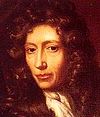 |
Scientist and theologian who argued that the study of science could improve glorification of God. |
1701–1800 (18th century)
The 18th century is considered the zenith of the EnlightenmentAge of Enlightenment
The Age of Enlightenment was an elite cultural movement of intellectuals in 18th century Europe that sought to mobilize the power of reason in order to reform society and advance knowledge. It promoted intellectual interchange and opposed intolerance and abuses in church and state...
. It was not a single movement or school of thought, it was less a set of ideas than it was a set of values. At its core was a critical questioning of traditional institution
Institution
An institution is any structure or mechanism of social order and cooperation governing the behavior of a set of individuals within a given human community...
s, custom
Custom
Custom may refer to:* Convention , a set of agreed, stipulated or generally accepted rules, norms, standards or criteria, often taking the form of a custom* Customization , anything made or modified to personal taste...
s, and moral
Moral
A moral is a message conveyed or a lesson to be learned from a story or event. The moral may be left to the hearer, reader or viewer to determine for themselves, or may be explicitly encapsulated in a maxim...
s, and a strong belief in rationality
Rationality
In philosophy, rationality is the exercise of reason. It is the manner in which people derive conclusions when considering things deliberately. It also refers to the conformity of one's beliefs with one's reasons for belief, or with one's actions with one's reasons for action...
and science. The end of the century saw the French Revolution
French Revolution
The French Revolution , sometimes distinguished as the 'Great French Revolution' , was a period of radical social and political upheaval in France and Europe. The absolute monarchy that had ruled France for centuries collapsed in three years...
which led to the first major de-Christianization attempts in Europe to occur in many centuries. This culminated in the Cult of the Supreme Being
Cult of the Supreme Being
The Cult of the Supreme Being was a form of deism established in France by Maximilien Robespierre during the French Revolution. It was intended to become the state religion of the new French Republic.- Origins :...
. The period thus saw Christianity in transition and eventually conflict.
| Name | Image | Reason for inclusion |
|---|---|---|
| John Wallis (1616–1703) | 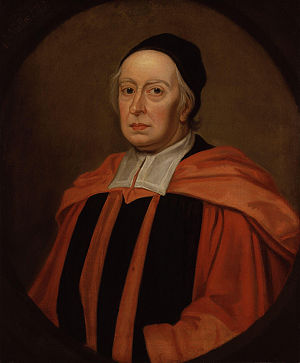 |
As a mathematician he wrote Arithmetica Infinitorumis, introduced the term Continued fraction Continued fraction In mathematics, a continued fraction is an expression obtained through an iterative process of representing a number as the sum of its integer part and the reciprocal of another number, then writing this other number as the sum of its integer part and another reciprocal, and so on... , worked on cryptography, helped develop calculus, and is further known for the Wallis product. He also devised a system for teaching the non-speaking deaf Deaf culture Deaf culture describes the social beliefs, behaviors, art, literary traditions, history, values and shared institutions of communities that are affected by deafness and which use sign languages as the main means of communication. When used as a cultural label, the word deaf is often written with a... . He was also a Calvinist inclined chaplain who was active in theological debate. |
| John Ray John Ray John Ray was an English naturalist, sometimes referred to as the father of English natural history. Until 1670, he wrote his name as John Wray. From then on, he used 'Ray', after "having ascertained that such had been the practice of his family before him".He published important works on botany,... (1627–1705) |
 |
English botanist who wrote The Wisdom of God manifested in the Works of the Creation. (1691) The John Ray Initiative of Environment and Christianity is also named for him. |
| Gottfried Leibniz Gottfried Leibniz Gottfried Wilhelm Leibniz was a German philosopher and mathematician. He wrote in different languages, primarily in Latin , French and German .... (1646–1716) |
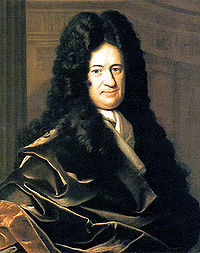 |
Polymath Polymath A polymath is a person whose expertise spans a significant number of different subject areas. In less formal terms, a polymath may simply be someone who is very knowledgeable... who worked on determinants, a calculating machine Calculating machine A calculating machine is a machine designed to come up with calculations or, in other words, computations. One noted machine was the Victorian British scientist Charles Babbage's Difference Engine , designed in the 1840s but never completed in the inventor's lifetime... , He was a Lutheran who worked with convert to Catholicism John Frederick, Duke of Brunswick-Lüneburg John Frederick, Duke of Brunswick-Lüneburg John Frederick was duke of Brunswick-Lüneburg and ruled over the Principality of Calenberg, a subdivision of the duchy, from 1665 until his death.... in hopes of a reunification between Catholicism and Lutheranism. He also wrote Vindication of the Justice of God. |
| Isaac Newton Isaac Newton Sir Isaac Newton PRS was an English physicist, mathematician, astronomer, natural philosopher, alchemist, and theologian, who has been "considered by many to be the greatest and most influential scientist who ever lived."... (1643–1727) |
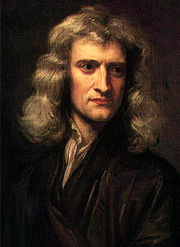 |
He is regarded as one of the greatest scientists and mathematicians in history. Newton's study of the Bible and of the early Church Fathers Church Fathers The Church Fathers, Early Church Fathers, Christian Fathers, or Fathers of the Church were early and influential theologians, eminent Christian teachers and great bishops. Their scholarly works were used as a precedent for centuries to come... were among his greatest passions, though he consistently refused to swear his allegiance to the church. He wrote Observations upon the Prophecies of Daniel and the Apocalypse of St. John (Nontrinitarianism Nontrinitarianism Nontrinitarianism includes all Christian belief systems that disagree with the doctrine of the Trinity, namely, the teaching that God is three distinct hypostases and yet co-eternal, co-equal, and indivisibly united in one essence or ousia... ). |
| Colin Maclaurin Colin Maclaurin Colin Maclaurin was a Scottish mathematician who made important contributions to geometry and algebra. The Maclaurin series, a special case of the Taylor series, are named after him.... (1698–1746) |
 |
Proposed to explain Newton's Isaac Newton Sir Isaac Newton PRS was an English physicist, mathematician, astronomer, natural philosopher, alchemist, and theologian, who has been "considered by many to be the greatest and most influential scientist who ever lived."... differential calculus Differential calculus In mathematics, differential calculus is a subfield of calculus concerned with the study of the rates at which quantities change. It is one of the two traditional divisions of calculus, the other being integral calculus.... using infinite series Series (mathematics) A series is the sum of the terms of a sequence. Finite sequences and series have defined first and last terms, whereas infinite sequences and series continue indefinitely.... instead of Newton's fluxions Method of Fluxions Method of Fluxions is a book by Isaac Newton. The book was completed in 1671, and published in 1736. Fluxions is Newton's term for differential calculus... . A Divinity student Divinity School Divinity School may refer to:* The common noun, divinity school* When used as a proper noun, may be an abbreviated reference to one of the following:** Beeson Divinity School** Berkeley Divinity School** Brite Divinity School... , he had a Christian institute named for him. |
| Stephen Hales Stephen Hales Stephen Hales, FRS was an English physiologist, chemist and inventor.Hales studied the role of air and water in the maintenance of both plant and animal life. He gave accurate accounts of the movements of water in plants, and demonstrated that plants absorb air... (1677–1761) |
 |
A Copley Medal Copley Medal The Copley Medal is an award given by the Royal Society of London for "outstanding achievements in research in any branch of science, and alternates between the physical sciences and the biological sciences"... winning scientist significant to the study of plant physiology. As an inventor designed a type of ventilation system, a means to distill sea-water, ways to preserve meat, etc. In religion he was an Anglican curate who worked with the Society for the Promotion of Christian Knowledge and for a group working to convert black slaves in the West Indies. |
| Thomas Bayes Thomas Bayes Thomas Bayes was an English mathematician and Presbyterian minister, known for having formulated a specific case of the theorem that bears his name: Bayes' theorem... (1701–1761) |
Presbyterian minister who wrote Divine Benevolence, or an Attempt to Prove That the Principal End of the Divine Providence and Government is the Happiness of His Creatures. He is better known for Bayes' theorem Bayes' theorem In probability theory and applications, Bayes' theorem relates the conditional probabilities P and P. It is commonly used in science and engineering. The theorem is named for Thomas Bayes .... and was made a Fellow of the Royal Society in 1742. |
|
| Firmin Abauzit (1679–1767) | 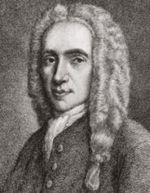 |
A physicist and theologian. He translated the New Testament New Testament The New Testament is the second major division of the Christian biblical canon, the first such division being the much longer Old Testament.... into French and corrected an error in Newton's Principia. |
| Emanuel Swedenborg Emanuel Swedenborg was a Swedish scientist, philosopher, and theologian. He has been termed a Christian mystic by some sources, including the Encyclopædia Britannica online version, and the Encyclopedia of Religion , which starts its article with the description that he was a "Swedish scientist and mystic." Others... (1688–1772) |
 |
His writing is the basis of Swedenborgianism and several of his theological works contained some science hypotheses, most notably the Nebular hypothesis for the origin of the Solar System. |
| Carolus Linnaeus Carolus Linnaeus Carl Linnaeus , also known after his ennoblement as , was a Swedish botanist, physician, and zoologist, who laid the foundations for the modern scheme of binomial nomenclature. He is known as the father of modern taxonomy, and is also considered one of the fathers of modern ecology... (1707–1778) |
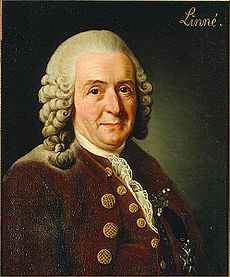 |
He is known as the "father of modern taxonomy Taxonomy Taxonomy is the science of identifying and naming species, and arranging them into a classification. The field of taxonomy, sometimes referred to as "biological taxonomy", revolves around the description and use of taxonomic units, known as taxa... " and also made contributions to ecology. Natural theology and the Bible were important to his Systema Naturae and Systema Vegetabilium.' |
| Leonhard Euler Leonhard Euler Leonhard Euler was a pioneering Swiss mathematician and physicist. He made important discoveries in fields as diverse as infinitesimal calculus and graph theory. He also introduced much of the modern mathematical terminology and notation, particularly for mathematical analysis, such as the notion... (1707–1783) |
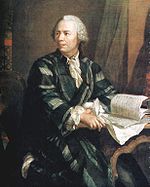 |
A significant mathematician and physicist, see List of topics named after Leonhard Euler. He wrote Defense of the Divine Revelation against the Objections of the Freethinkers and is also commemorated by the Lutheran Church on their Calendar of Saints on May 24. |
| Maria Gaetana Agnesi Maria Gaetana Agnesi Maria Gaetana Agnesi was an Italian linguist, mathematician, and philosopher. Agnesi is credited with writing the first book discussing both differential and integral calculus. She was an honorary member of the faculty at the University of Bologna... (1718–1799) |
Mathematician appointed to a position by Pope Benedict XIV Pope Benedict XIV Pope Benedict XIV , born Prospero Lorenzo Lambertini, was Pope from 17 August 1740 to 3 May 1758.-Life:... . After her father died she devoted her life to religious studies, charity, and ultimately became a nun. |
1801–1900 (19th century)
This period led Christians in science to face changes and increased challenges. It was the 19th century that brought the professionalizationProfessionalization
Professionalization is the social process by which any trade or occupation transforms itself into a true "profession of the highest integrity and competence." This process tends to involve establishing acceptable qualifications, a professional body or association to oversee the conduct of members...
of the scientific enterprise. By then, religious thinkers who expressed themselves on scientific subjects were increasingly treated as "trespassers". This was also the first century that saw actual discussions of the "relationship between science and religion". In previous ages there was occasional concern about tension between faith and reason, but religion and science were not presented as two opposing forces. This ethos gave birth to the conflict thesis
Conflict thesis
The conflict thesis proposes an intrinsic intellectual conflict between religion and science. The original historical usage of the term denoted that the historical record indicates religion’s perpetual opposition to science. Later uses of the term denote religion’s epistemological opposition to...
. At the end of the century it was common the view that science and religion "had been in a state of constant conflict". This notion is still very popular, although it is not endorsed by current research on the history of science
History of science
The history of science is the study of the historical development of human understandings of the natural world and the domains of the social sciences....
.
| Name | Image | Reason for inclusion |
|---|---|---|
| Joseph Priestley Joseph Priestley Joseph Priestley, FRS was an 18th-century English theologian, Dissenting clergyman, natural philosopher, chemist, educator, and political theorist who published over 150 works... (1733–1804) |
Nontrinitarianism Nontrinitarianism Nontrinitarianism includes all Christian belief systems that disagree with the doctrine of the Trinity, namely, the teaching that God is three distinct hypostases and yet co-eternal, co-equal, and indivisibly united in one essence or ousia... clergyman who wrote the controversial work History of the Corruptions of Christianity. He is credited with discovering oxygen Oxygen Oxygen is the element with atomic number 8 and represented by the symbol O. Its name derives from the Greek roots ὀξύς and -γενής , because at the time of naming, it was mistakenly thought that all acids required oxygen in their composition... , although Carl Wilhelm Scheele Carl Wilhelm Scheele Carl Wilhelm Scheele was a German-Swedish pharmaceutical chemist. Isaac Asimov called him "hard-luck Scheele" because he made a number of chemical discoveries before others who are generally given the credit... did so a year earlier. |
|
| Isaac Milner Isaac Milner Isaac Milner FRS was a mathematician, an inventor, the President of Queens' College, Cambridge and Lucasian Professor of Mathematics.... (1750–1820) |
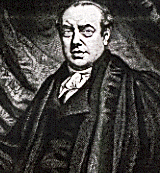 |
Lucasian Professor of Mathematics known for work on an important process to fabricate Nitrous acid Nitrous acid Nitrous acid is a weak and monobasic acid known only in solution and in the form of nitrite salts.Nitrous acid is used to make diazides from amines; this occurs by nucleophilic attack of the amine onto the nitrite, reprotonation by the surrounding solvent, and double-elimination of water... . He was also an evangelical Anglican who co-wrote Ecclesiastical History of the Church of Christ with his brother and played a role in the religious awakening of William Wilberforce William Wilberforce William Wilberforce was a British politician, a philanthropist and a leader of the movement to abolish the slave trade. A native of Kingston upon Hull, Yorkshire, he began his political career in 1780, eventually becoming the independent Member of Parliament for Yorkshire... . He also led to William Frend William Frend (social reformer) William Frend was an English clergyman , social reformer and writer. After a high-profile university trial in Cambridge deprived of his residency rights as fellow of his college, he became a leading figure in London radical circles.-Early life:Son of a Canterbury trader, he was born on 22 November... being expelled from Cambridge for a purported attack by Frend on religion. |
| Samuel Vince Samuel Vince Samuel Vince was an English clergyman, mathematician and astronomer at the University of Cambridge.The son of a plasterer, Vince was admitted as a sizar to Caius College, Cambridge in 1771. In 1775 he was Senior Wrangler at Cambridge. Migrating to Sidney Sussex College in 1777, he gained his M.A.... (1749–1821) |
Cambridge astronomer and clergyman. He wrote Observations on the Theory of the Motion and Resistance of Fluids and The credibility of Christianity vindicated, in answer to Mr. Hume’s objections. He won the Copley Medal Copley Medal The Copley Medal is an award given by the Royal Society of London for "outstanding achievements in research in any branch of science, and alternates between the physical sciences and the biological sciences"... in 1780, before the period dealt with here ended. |
|
| Olinthus Gregory Olinthus Gregory Olinthus Gilbert Gregory was an English mathematician, author and editor.He was born on 29 January 1774 at Yaxley in Huntingdonshire. Having been educated by Richard Weston, a Leicester botanist, in 1793 he published a treatise, Lessons Astronomical and Philosophical... (1774–1841) |
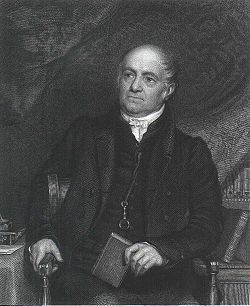 |
He wrote Lessons Astronomical and Philosophical in 1793 and became mathematical master at the Royal Military Academy in 1802. An abridgment of his 1815 Letters on the Evidences of Christianity was done by the Religious Tract Society Religious Tract Society The Religious Tract Society, founded 1799, 56 Paternoster Row and 65 St. Paul's Chuchyard, was the original name of a major British publisher of Christian literature intended initially for evangelism, and including literature aimed at children, women, and the poor.The RTS is also notable for being... . |
| William Buckland William Buckland The Very Rev. Dr William Buckland DD FRS was an English geologist, palaeontologist and Dean of Westminster, who wrote the first full account of a fossil dinosaur, which he named Megalosaurus... (1784–1856) |
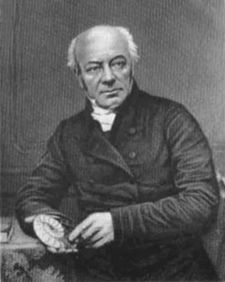 |
Anglican priest/geologist who wrote Vindiciae Geologiae; or the Connexion of Geology with Religion explained. He was born in 1784, but his scientific life did not begin before the period discussed herein. |
| Augustin Louis Cauchy Augustin Louis Cauchy Baron Augustin-Louis Cauchy was a French mathematician who was an early pioneer of analysis. He started the project of formulating and proving the theorems of infinitesimal calculus in a rigorous manner, rejecting the heuristic principle of the generality of algebra exploited by earlier authors... (1789–1857) |
Mathematician who defended the Society of Jesus Society of Jesus The Society of Jesus is a Catholic male religious order that follows the teachings of the Catholic Church. The members are called Jesuits, and are also known colloquially as "God's Army" and as "The Company," these being references to founder Ignatius of Loyola's military background and a... , tried to convert other mathematicians to Catholicism, and was a member of the Society of Saint Vincent de Paul Society of Saint Vincent de Paul The St Vincent de Paul Society is an international Roman Catholic voluntary organization dedicated to tackling poverty and disadvantage by providing direct practical assistance to anyone in need. Active in England & Wales since 1844, today it continues to address social and material need in all... . |
|
| Lars Levi Læstadius Lars Levi Læstadius Lars Levi Læstadius was a Swedish Lutheran pastor of partly Sami ancestry. From the mid 1840s and onward he became the leader of the Laestadian movement... (1800–1861) |
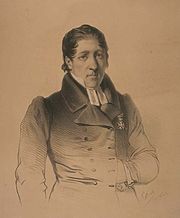 |
Botanist who started a revival movement within Lutheranism Lutheranism Lutheranism is a major branch of Western Christianity that identifies with the theology of Martin Luther, a German reformer. Luther's efforts to reform the theology and practice of the church launched the Protestant Reformation... called Laestadianism Laestadianism Laestadianism is a conservative Lutheran revival movement started in the middle of the 19th century. It is strongly marked by both pietistic and Moravian influences. It is the biggest revivalist movement in the Nordic countries. It has members mainly in Finland, North America, Norway, Russia and... . This movement is among the strictest forms of Lutheranism. As a botanist he has the author citation Author citation (botany) In botanical nomenclature, author citation refers to citing the person who validly published a botanical name, i.e. who first published the name while fulfilling the formal requirements as specified by the International Code of Botanical Nomenclature... Laest and discovered four species. |
| Edward Hitchcock Edward Hitchcock Edward Hitchcock was a noted American geologist and the third President of Amherst College .-Life:... (1793–1864) |
Geologist, paleontologist, and Congregationalist pastor. He worked on Natural theology Natural theology Natural theology is a branch of theology based on reason and ordinary experience. Thus it is distinguished from revealed theology which is based on scripture and religious experiences of various kinds; and also from transcendental theology, theology from a priori reasoning.Marcus Terentius Varro ... and wrote on fossil Fossil Fossils are the preserved remains or traces of animals , plants, and other organisms from the remote past... ized tracks. |
|
| William Whewell William Whewell William Whewell was an English polymath, scientist, Anglican priest, philosopher, theologian, and historian of science. He was Master of Trinity College, Cambridge.-Life and career:Whewell was born in Lancaster... (1794–1866) |
A professor of mineralogy and moral philosophy. He wrote An Elementary Treatise on Mechanics in 1819 and Astronomy and General Physics considered with reference to Natural Theology in 1833. | |
| Michael Faraday Michael Faraday Michael Faraday, FRS was an English chemist and physicist who contributed to the fields of electromagnetism and electrochemistry.... (1791–1867) |
 |
A Glasite Glasite The Glasites or Glassites were a Christian sect founded in about 1730 in Scotland by John Glas. Glas' faith, as part of the First Great Awakening, was spread by his son-in-law Robert Sandeman into England and America, where the members were called Sandemanians.Glas dissented from the Westminster... church elder for a time, he discussed the relationship of science to religion in a lecture opposing Spiritualism Spiritualism Spiritualism is a belief system or religion, postulating the belief that spirits of the dead residing in the spirit world have both the ability and the inclination to communicate with the living... . |
| Charles Babbage Charles Babbage Charles Babbage, FRS was an English mathematician, philosopher, inventor and mechanical engineer who originated the concept of a programmable computer... (1791–1871) |
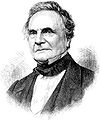 |
The Difference Engine Difference engine A difference engine is an automatic, mechanical calculator designed to tabulate polynomial functions. Both logarithmic and trigonometric functions can be approximated by polynomials, so a difference engine can compute many useful sets of numbers.-History:... and the Ninth Bridgewater Treatise. |
| Adam Sedgwick Adam Sedgwick Adam Sedgwick was one of the founders of modern geology. He proposed the Devonian period of the geological timescale... (1785–1873) |
Anglican priest and geologist whose, A Discourse on the Studies of the University discusses the relationship of God and man. In science he won both the Copley Medal and the Wollaston Medal Wollaston Medal The Wollaston Medal is a scientific award for geology, the highest award granted by the Geological Society of London.The medal is named after William Hyde Wollaston, and was first awarded in 1831... . |
|
| Temple Chevallier Temple Chevallier Temple Chevallier was a British clergyman, astronomer, and mathematician. Between 1847 and 1849, he made important observations regarding sunspots. Chevallier has been called "a remarkable Victorian polymath"... (1794–1873) |
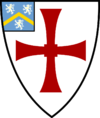 |
Priest and astronomer who did Of the proofs of the divine power and wisdom derived from the study of astronomy. He also founded the Durham University Observatory Durham University Observatory The Durham University Observatory is a weather observatory owned and operated by the University of Durham. It is a Grade II listed building located at Potters Bank, Durham and was founded in 1839 initially as an astronomical and meteorological observatory by Temple Chevallier until 1937 when the... , hence the Durham Shield is pictured. |
| John Bachman John Bachman The Rev. John Bachman was an American Lutheran minister, social activist and naturalist who collaborated with J.J. Audubon to produce Viviparous Quadrapeds of North America and whose writings, particularly Unity of the Human Race, were influential in the development of the theory of evolution. He... (1790–1874) |
Wrote numerous scientific articles and named several species of animals. He also was a founder of the Lutheran Theological Southern Seminary Lutheran Theological Southern Seminary Lutheran Theological Southern Seminary , located in Columbia, South Carolina is a theological seminary of the Evangelical Lutheran Church in America offering first and second professional theological degrees.-History:... and wrote works on Lutheranism Lutheranism Lutheranism is a major branch of Western Christianity that identifies with the theology of Martin Luther, a German reformer. Luther's efforts to reform the theology and practice of the church launched the Protestant Reformation... . |
|
| Robert Main Robert Main The Reverend Robert Main was an English astronomer.Born in Kent, the eldest son of Thomas Main, Robert Main attended school in Portsea before studying mathematics at Queens' College, Cambridge, where he graduated as sixth wrangler in 1834... (1808–1878) |
Anglican priest who won the Gold Medal of the Royal Astronomical Society Gold Medal of the Royal Astronomical Society -History:In the early years, more than one medal was often awarded in a year, but by 1833 only one medal was being awarded per year. This caused a problem when Neptune was discovered in 1846, because many felt an award should jointly be made to John Couch Adams and Urbain Le Verrier... in 1858. (The image is of Asaph Hall Asaph Hall Asaph Hall III was an American astronomer who is most famous for having discovered the moons of Mars in 1877... 's 1879 Gold Medal of the RAS.) Robert Main also preached at the British Association of Bristol Bristol Bristol is a city, unitary authority area and ceremonial county in South West England, with an estimated population of 433,100 for the unitary authority in 2009, and a surrounding Larger Urban Zone with an estimated 1,070,000 residents in 2007... . |
|
| James Clerk Maxwell James Clerk Maxwell James Clerk Maxwell of Glenlair was a Scottish physicist and mathematician. His most prominent achievement was formulating classical electromagnetic theory. This united all previously unrelated observations, experiments and equations of electricity, magnetism and optics into a consistent theory... (1831–1879) |
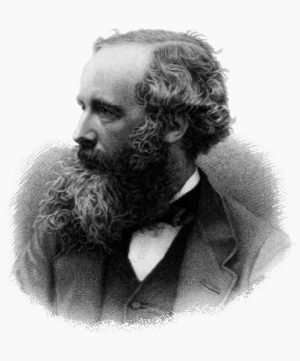 |
Although Clerk as a boy was taken to Presbyterian services by his father and to Anglican services by his aunt, while still a young student at Cambridge he underwent an Evangelical conversion that he described as having given him a new perception of the Love of God.In the biography by Cambell (p. 170) Maxwell's conversion is described: "He referred to it long afterwards as having given him a new perception of the Love of God. One of his strongest convictions thenceforward was that 'Love abideth, though Knowledge vanish away.'" Maxwell's evangelicalism "committed him to an anti-positivist position." |
| Arnold Henry Guyot Arnold Henry Guyot Arnold Henry Guyot was a Swiss-American geologist and geographer.-Biography:... (1807–1884) |
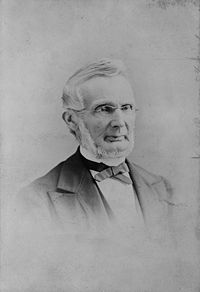 |
Swiss-American geologist who did noteworthy work on glaciers, Guyot Glacier Guyot Glacier Guyot Glacier is a long and wide glacier located in the east end of the Robinson Mountains in the U.S. state of Alaska. It begins north of Yaga Peak and heads east-southeast to Icy Bay, south of the Guyot Hills and northwest of Yakutat. It borders Yahtse Glacier on the northeast. The glacier... is named for him. He also wrote Creation, or the Biblical Cosmogony in the Light of Modern Science. |
| Gregor Mendel Gregor Mendel Gregor Johann Mendel was an Austrian scientist and Augustinian friar who gained posthumous fame as the founder of the new science of genetics. Mendel demonstrated that the inheritance of certain traits in pea plants follows particular patterns, now referred to as the laws of Mendelian inheritance... (1822–1884) |
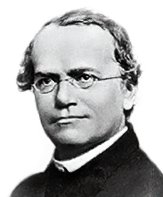 |
Augustinian Abbot Abbot The word abbot, meaning father, is a title given to the head of a monastery in various traditions, including Christianity. The office may also be given as an honorary title to a clergyman who is not actually the head of a monastery... who was the "father of modern genetics" for his study of the inheritance of traits in pea plants. |
| Philip Henry Gosse Philip Henry Gosse Philip Henry Gosse was an English naturalist and popularizer of natural science, virtually the inventor of the seawater aquarium, and a painstaking innovator in the study of marine biology... (1810–1888) |
.jpg) |
Marine biologist who wrote Aquarium (1854), and A Manual of Marine Zoology (1855–56). He is more famous, or infamous, as a Christian Fundamentalist who coined the idea of Omphalos (theology) Omphalos (theology) The Omphalos hypothesis was named after the title of an 1857 book, Omphalos by Philip Henry Gosse, in which Gosse argued that in order for the world to be "functional", God must have created the Earth with mountains and canyons, trees with growth rings, Adam and Eve with hair, fingernails, and... . |
| Asa Gray Asa Gray -References:*Asa Gray. Dictionary of American Biography. American Council of Learned Societies, 1928–1936.*Asa Gray. Encyclopedia of World Biography, 2nd ed. 17 Vols. Gale Research, 1998.*Asa Gray. Plant Sciences. 4 vols. Macmillan Reference USA, 2001.... (1810–1888) |
His Gray's Manual remains a pivotal work in botany. His Darwiniana Darwiniana Darwiniana is a collection of essays by botanist Asa Gray. The articles both defended the theory of evolution from the standpoint of botany, and sought reconciliation with theology by arguing theistic evolution, that natural selection is not inconsistent with Natural Theology.-References:* Gray,... has sections titled "Natural selection not inconsistent with Natural theology", "Evolution and theology", and "Evolutionary teleology." The preface indicates his adherence to the Nicene Creed Nicene Creed The Nicene Creed is the creed or profession of faith that is most widely used in Christian liturgy. It is called Nicene because, in its original form, it was adopted in the city of Nicaea by the first ecumenical council, which met there in the year 325.The Nicene Creed has been normative to the... in concerning these religious issues. |
|
| Francesco Faà di Bruno Francesco Faà di Bruno Francesco Faà di Bruno was an Italian mathematician and priest, born at Alessandria. He was of noble birth, and held, at one time, the rank of captain-of-staff in the Sardinian Army. He is the eponym of Faà di Bruno's formula... (1825—1888) |
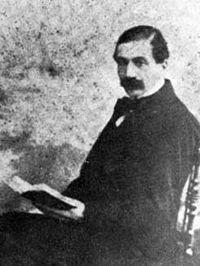 |
Italian mathematician most linked to Turin Turin Turin is a city and major business and cultural centre in northern Italy, capital of the Piedmont region, located mainly on the left bank of the Po River and surrounded by the Alpine arch. The population of the city proper is 909,193 while the population of the urban area is estimated by Eurostat... . He is known for Faà di Bruno's formula Faà di Bruno's formula Faà di Bruno's formula is an identity in mathematics generalizing the chain rule to higher derivatives, named after , though he was not the first to state or prove the formula... and being a spiritual writer beatified in 1988. |
| Julian Tenison Woods Julian Tenison Woods Julian Edmund Tenison Woods was an English Roman Catholic priest and geologist, active in Australia. With Saint Mary MacKillop, he helped to found the Sisters of St Joseph of the Sacred Heart at Penola in 1866.... (1832–1889) |
Co-founder of the Sisters of St Joseph of the Sacred Heart Sisters of St Joseph of the Sacred Heart The Sisters of Saint Joseph of the Sacred Heart, often called the Josephites , were founded in Penola, South Australia in 1866 by Mary MacKillop and Father Julian Tenison Woods.... who won a Clarke Medal Clarke Medal The Clarke Medal is awarded by the Royal Society of New South Wales for distinguished work in the Natural sciences.Named in honour of the Reverend William Branwhite Clarke, one of the founders of the Society... shortly before death. A picture from Waverley Cemetery Waverley Cemetery The Waverley Cemetery opened in 1877 and is a cemetery located on top of the cliffs at Bronte in the eastern suburbs of Sydney. It is noted for its largely intact Victorian and Edwardian monuments. The cemetery contains the graves of many significant Australians including the poet Henry Lawson and... , where he's buried, is shown. |
|
| James Dwight Dana James Dwight Dana James Dwight Dana was an American geologist, mineralogist and zoologist. He made pioneering studies of mountain-building, volcanic activity, and the origin and structure of continents and oceans around the world.-Early life and career:... (1813–1895) |
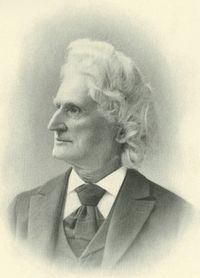 |
A geologist, mineralogist, and zoologist. He received the Copley Medal, Wollaston Medal Wollaston Medal The Wollaston Medal is a scientific award for geology, the highest award granted by the Geological Society of London.The medal is named after William Hyde Wollaston, and was first awarded in 1831... , and the Clarke Medal Clarke Medal The Clarke Medal is awarded by the Royal Society of New South Wales for distinguished work in the Natural sciences.Named in honour of the Reverend William Branwhite Clarke, one of the founders of the Society... . He also wrote a book titled Science and the Bible and his faith has been described as "both orthodox and intense." |
| Louis Pasteur Louis Pasteur Louis Pasteur was a French chemist and microbiologist born in Dole. He is remembered for his remarkable breakthroughs in the causes and preventions of diseases. His discoveries reduced mortality from puerperal fever, and he created the first vaccine for rabies and anthrax. His experiments... (1822–1895) |
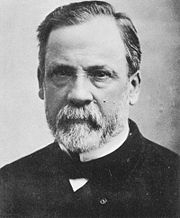 |
Inventor of the pasteurization Pasteurization Pasteurization is a process of heating a food, usually liquid, to a specific temperature for a definite length of time, and then cooling it immediately. This process slows microbial growth in food... method, a French chemist and microbiologist. He also solved the mysteries of rabies, anthrax, chicken cholera, and silkworm diseases, and contributed to the development of the first vaccines. |
| George Jackson Mivart (1827–1900) | Fellow of the Zoological Society of London Zoological Society of London The Zoological Society of London is a charity devoted to the worldwide conservation of animals and their habitats... who did notable work on Insectivora Insectivora The order Insectivora is a now-abandoned biological grouping within the class of mammals... and became involved in controversies with Charles Darwin Charles Darwin Charles Robert Darwin FRS was an English naturalist. He established that all species of life have descended over time from common ancestry, and proposed the scientific theory that this branching pattern of evolution resulted from a process that he called natural selection.He published his theory... . He was also a convert to Catholicism who taught at the Catholic University of Leuven Catholic University of Leuven The Catholic University of Leuven, or of Louvain, was the largest, oldest and most prominent university in Belgium. The university was founded in 1425 as the University of Leuven by John IV, Duke of Brabant and approved by a Papal bull by Pope Martin V.During France's occupation of Belgium in the... and received a Doctor of Philosophy from Pope Pius IX Pope Pius IX Blessed Pope Pius IX , born Giovanni Maria Mastai-Ferretti, was the longest-reigning elected Pope in the history of the Catholic Church, serving from 16 June 1846 until his death, a period of nearly 32 years. During his pontificate, he convened the First Vatican Council in 1869, which decreed papal... in 1876, However his later works were considered unorthodox and led to his excommunication by Cardinal Vaughan. |
|
| Armand David Armand David Father Armand David was a Lazarist missionary Catholic priest as well as a zoologist and a botanist.-General Biography:... (1826–1900) |
Catholic missionary to China and member of the Lazarists Lazarists Congregation of the Mission is a vowed order of priests and brothers associated with the Vincentian Family, a loose federation of organizations who claim St. Vincent de Paul as their founder or Patron... who considered his religious duties to be his principal concern. He was also a botanist with the author abbreviation David and as a zoologist he described several species new to the West. |
1901–2000 (20th century)
During the previous century, the practice of science became professionalized and institutionalized in ways that continued through the 20th century. As the role of scientific knowledge grew in society, it became incorporated with many aspects of the functioning of nation-states.| Name | Image | Reason for inclusion |
|---|---|---|
| George Stokes George Gabriel Stokes Sir George Gabriel Stokes, 1st Baronet FRS , was an Irish mathematician and physicist, who at Cambridge made important contributions to fluid dynamics , optics, and mathematical physics... (1819–1903) |
A minister's son, he wrote a book on Natural Theology Natural theology Natural theology is a branch of theology based on reason and ordinary experience. Thus it is distinguished from revealed theology which is based on scripture and religious experiences of various kinds; and also from transcendental theology, theology from a priori reasoning.Marcus Terentius Varro ... . He was also one of the Presidents of the Royal Society and made contributions to Fluid dynamics Fluid dynamics In physics, fluid dynamics is a sub-discipline of fluid mechanics that deals with fluid flow—the natural science of fluids in motion. It has several subdisciplines itself, including aerodynamics and hydrodynamics... . |
|
| George Salmon George Salmon The Reverend George Salmon was an Irish mathematician and theologian. His publications in algebraic geometry were widely read in the second half of the 19th century, but he devoted himself mostly to theology for the last forty years of his life... (1819–1904) |
.jpg) |
He won the Copley Medal for his mathematical works. In theology his book An Historical Introduction to the Study of the Books of the New Testament was widely read and he wrote rebuttals to John Henry Newman tracts. |
| Henry Baker Tristram Henry Baker Tristram The Reverend Henry Baker Tristram FRS was an English clergyman, Biblical scholar, traveller and ornithologist.Tristram was born at Eglingham vicarage, near Alnwick, Northumberland, and studied at Durham School and Lincoln College, Oxford. In 1846 he was ordained a priest, but he suffered from... (1822–1906) |
A founding member of the British Ornithologists' Union British Ornithologists' Union The British Ornithologists' Union aims to encourage the study of birds in Britain, Europe and elsewhere, in order to understand their biology and to aid their conservation.... . His publications included The Natural History of the Bible (1867) and The Fauna and Flora of Palestine (1884). |
|
| Lord Kelvin William Thomson, 1st Baron Kelvin William Thomson, 1st Baron Kelvin OM, GCVO, PC, PRS, PRSE, was a mathematical physicist and engineer. At the University of Glasgow he did important work in the mathematical analysis of electricity and formulation of the first and second laws of thermodynamics, and did much to unify the emerging... (1824–1907) |
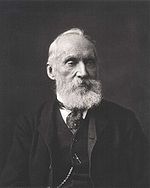 |
He gave a famous address to the Christian Evidence Society Christian Evidence Society The Christian Evidence Society is a UK Christian apologetics organisation founded in 1870. At its financial peak it had slightly over 400 paying members, but this declined to below 300 by 1897... . In science he won the Copley Medal, the Royal Medal Royal Medal The Royal Medal, also known as The Queen's Medal, is a silver-gilt medal awarded each year by the Royal Society, two for "the most important contributions to the advancement of natural knowledge" and one for "distinguished contributions in the applied sciences" made within the Commonwealth of... , and was important in Thermodynamics Timeline of thermodynamics, statistical mechanics, and random processes A timeline of events related to thermodynamics.- Before 1800 :* 1650 – Otto von Guericke builds the first vacuum pump* 1660 – Robert Boyle experimentally discovers Boyle's Law, relating the pressure and volume of a gas... . |
| Pierre Duhem Pierre Duhem Pierre Maurice Marie Duhem was a French physicist, mathematician and philosopher of science, best known for his writings on the indeterminacy of experimental criteria and on scientific development in the Middle Ages... (1861–1916) |
 |
He worked on Thermodynamic potentials Thermodynamic potentials A thermodynamic potential is a scalar function used to represent the thermodynamic state of a system. The concept of thermodynamic potentials was introduced by Pierre Duhem in 1886. Josiah Willard Gibbs in his papers used the term fundamental functions. One main thermodynamic potential that has a... and wrote histories advocating that the Roman Catholic Church helped advance science. |
| Georg Cantor Georg Cantor Georg Ferdinand Ludwig Philipp Cantor was a German mathematician, best known as the inventor of set theory, which has become a fundamental theory in mathematics. Cantor established the importance of one-to-one correspondence between the members of two sets, defined infinite and well-ordered sets,... (1845–1918) |
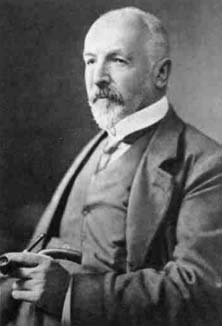 |
Lutheran Lutheranism Lutheranism is a major branch of Western Christianity that identifies with the theology of Martin Luther, a German reformer. Luther's efforts to reform the theology and practice of the church launched the Protestant Reformation... who wrote on religious topics and had an interest in Medieval theology Theology Theology is the systematic and rational study of religion and its influences and of the nature of religious truths, or the learned profession acquired by completing specialized training in religious studies, usually at a university or school of divinity or seminary.-Definition:Augustine of Hippo... . Revolutionized the mathematical notion of infinity by the introduction of set theory. |
| Henrietta Swan Leavitt Henrietta Swan Leavitt Henrietta Swan Leavitt was an American astronomer. A graduate of Radcliffe College, Leavitt went to work in 1893 at the Harvard College Observatory in a menial capacity as a "computer", assigned to count images on photographic plates... (1868–1921) |
A minister's daughter and noted astronomer who was the head of Photometry (astronomy) Photometry (astronomy) Photometry is a technique of astronomy concerned with measuring the flux, or intensity of an astronomical object's electromagnetic radiation... at Harvard. A practicing Congregationalist, Leavitt was the descendant of early Massachusetts Bay Colony Massachusetts Bay Colony The Massachusetts Bay Colony was an English settlement on the east coast of North America in the 17th century, in New England, situated around the present-day cities of Salem and Boston. The territory administered by the colony included much of present-day central New England, including portions... Puritan Puritan The Puritans were a significant grouping of English Protestants in the 16th and 17th centuries. Puritanism in this sense was founded by some Marian exiles from the clergy shortly after the accession of Elizabeth I of England in 1558, as an activist movement within the Church of England... settlers John Leavitt Deacon John Leavitt was a tailor, public officeholder, and founding deacon of Old Ship Church in Hingham, Plymouth County, Massachusetts, the only remaining 17th-century Puritan meeting house in America and the oldest church in continuous ecclesiastical use in the United States... . |
|
| Dmitri Egorov Dmitri Egorov - External links :... (1869–1931) |
Russian mathematician who made significant contributions to the broader areas of differential geometry. He was an Imiaslavie Imiaslavie Imiaslavie or Imiabozhie , also spelled imyaslavie and imyabozhie, and also referred to as onomatodoxy, is a dogmatic movement which was condemned by the Russian Orthodox Church, but that is still promoted by some affiliated with Gregory Lourie of the "Russian Orthodox Autonomous Church" , and by... who defended religion during the Soviet era. In 1930 the Soviets arrested and imprisoned him as a "religious sectarian." He died of a hunger strike in protest. |
|
| Mihajlo Idvorski Pupin (1858–1935) | 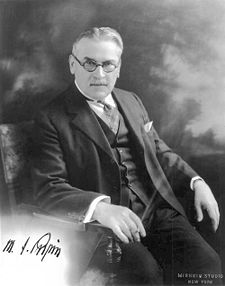 |
Serbian-American physicist, chemist, and inventor. He won the Pulitzer Prize for Biography or Autobiography Pulitzer Prize for Biography or Autobiography The Pulitzer Prize for Biography or Autobiography has been presented since 1917 for a distinguished biography or autobiography by an American author.-1910s:* 1917: Julia Ward Howe by Laura E... in 1924. His The New Reformation: From Physical to Spiritual Realities concerns religion and spirituality. He also wrote the forward to Science & Religion: A Symposium Science & Religion: A Symposium Science & Religion: A Symposium is a book first published in 1931, consisting of a lightly edited transcription of twelve talks broadcast on the BBC between September and December 1930. In contrast to the 1920’s conflicts between science and religion in the U.S. , 1920’s Great Britain experienced... . |
| Pavel Florensky Pavel Florensky Pavel Alexandrovich Florensky was a Russian Orthodox theologian, philosopher, mathematician, electrical engineer, inventor and Neomartyr sometimes compared by his followers to Leonardo da Vinci.-Early life:Pavel Aleksandrovich Florensky was born on January 21, 1882, into the family of a railroad... (1882–1937) |
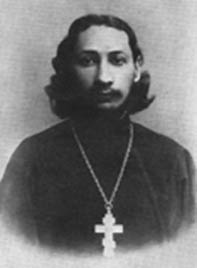 |
Russian Orthodox Russian Orthodox Church The Russian Orthodox Church or, alternatively, the Moscow Patriarchate The ROC is often said to be the largest of the Eastern Orthodox churches in the world; including all the autocephalous churches under its umbrella, its adherents number over 150 million worldwide—about half of the 300 million... priest who wrote a book on Dielectric Dielectric A dielectric is an electrical insulator that can be polarized by an applied electric field. When a dielectric is placed in an electric field, electric charges do not flow through the material, as in a conductor, but only slightly shift from their average equilibrium positions causing dielectric... s and wrote of imaginary numbers having a relationship to the Kingdom of God. |
| Agnes Giberne Agnes Giberne Agnes Giberne was a prolific British author who wrote fiction with moral or religious themes for children and also books on astronomy for young people.... (1845–1939) |
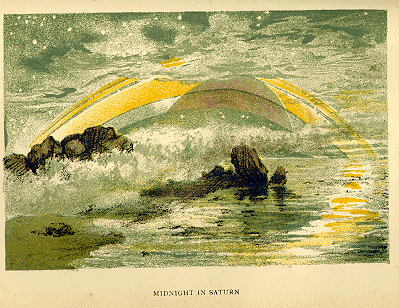 |
She wrote for the Religious Tract Society Religious Tract Society The Religious Tract Society, founded 1799, 56 Paternoster Row and 65 St. Paul's Chuchyard, was the original name of a major British publisher of Christian literature intended initially for evangelism, and including literature aimed at children, women, and the poor.The RTS is also notable for being... and was a founding member of the British Astronomical Association British Astronomical Association The British Astronomical Association is the senior national association of amateur astronomers in the UK.-Function:It encourages observational astronomy by non-professionals in areas which cannot be covered by professional observatories... . The picture comes from her book Sun, Moon and Stars, which references the Bible while discussing science. |
| John Ambrose Fleming John Ambrose Fleming Sir John Ambrose Fleming was an English electrical engineer and physicist. He is known for inventing the first thermionic valve or vacuum tube, the diode, then called the kenotron in 1904. He is also famous for the left hand rule... (1849–1945) |
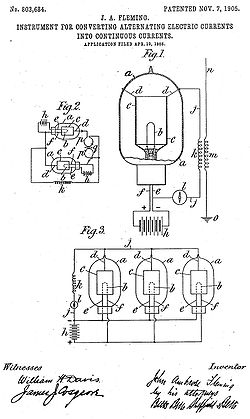 |
In science he is noted for the Right-hand rule Right-hand rule In mathematics and physics, the right-hand rule is a common mnemonic for understanding notation conventions for vectors in 3 dimensions. It was invented for use in electromagnetism by British physicist John Ambrose Fleming in the late 19th century.... and work on vacuum tube Vacuum tube In electronics, a vacuum tube, electron tube , or thermionic valve , reduced to simply "tube" or "valve" in everyday parlance, is a device that relies on the flow of electric current through a vacuum... s, hence the picture of a Fleming valve. He also won the Hughes Medal Hughes Medal The Hughes Medal is awarded by the Royal Society of London "in recognition of an original discovery in the physical sciences, particularly electricity and magnetism or their applications". Named after David E. Hughes, the medal is awarded with a gift of £1000. The medal was first awarded in 1902 to... . In religious activities he was President of the Victoria Institute Victoria Institute The Victoria Institute, or Philosophical Society of Great Britain, was founded in 1865, as a response to the publication of On the Origin of Species and Essays and Reviews. Its stated objective was to defend "the great truths revealed in Holy Scripture ..... , involved in the Creation Science Movement Creation Science Movement The Creation Science Movement is a British Creationist organisation which lays claim to the title "the oldest creationist movement in the world"... , and preached at St Martin-in-the-Fields St Martin-in-the-Fields St Martin-in-the-Fields is an Anglican church at the north-east corner of Trafalgar Square in the City of Westminster, London. Its patron is Saint Martin of Tours.-Roman era:Excavations at the site in 2006 led to the discovery of a grave dated about 410... . |
| Max Planck Max Planck Max Karl Ernst Ludwig Planck, ForMemRS, was a German physicist who actualized the quantum physics, initiating a revolution in natural science and philosophy. He is regarded as the founder of the quantum theory, for which he received the Nobel Prize in Physics in 1918.-Life and career:Planck came... (1858–1947) |
He won the 1918 Nobel Prize in Physics Nobel Prize in Physics The Nobel Prize in Physics is awarded once a year by the Royal Swedish Academy of Sciences. It is one of the five Nobel Prizes established by the will of Alfred Nobel in 1895 and awarded since 1901; the others are the Nobel Prize in Chemistry, Nobel Prize in Literature, Nobel Peace Prize, and... and is considered the founder of Quantum mechanics Quantum mechanics Quantum mechanics, also known as quantum physics or quantum theory, is a branch of physics providing a mathematical description of much of the dual particle-like and wave-like behavior and interactions of energy and matter. It departs from classical mechanics primarily at the atomic and subatomic... . He had been raised an observant Lutheran and was an elder in his church from 1920 to his death. In 1937 he delivered the lecture, "Religion and Natural Science", stating that both religion and science require a belief in God.He stated that: "Both Religion and science require a belief in God. For believers, God is in the beginning, and for physicists He is at the end of all considerations… To the former He is the foundation, to the latter, the crown of the edifice of every generalized world view." |
|
| Edward Arthur Milne (1896–1950) | British astrophysicist and mathematicians who proposed the Milne model Milne model The Milne model was a special relativistic cosmological model proposed by Edward Arthur Milne in 1935. It is mathematically equivalent to a special case of the FLRW model in the limit of zero energy density , and it obeys the cosmological principle... and had a Moon crater named for him Milne (crater) Milne is a large lunar crater that is located in the southern hemisphere on the far side of the Moon, named after the British mathematician and astrophysicist Edward Arthur Milne... . In addition he won several awards one of which, the Gold Medal of the Royal Astronomical Society Gold Medal of the Royal Astronomical Society -History:In the early years, more than one medal was often awarded in a year, but by 1833 only one medal was being awarded per year. This caused a problem when Neptune was discovered in 1846, because many felt an award should jointly be made to John Couch Adams and Urbain Le Verrier... , is pictured. His last book was Modern Cosmology and the Christian Idea of God. |
|
| Robert Millikan Robert Millikan Robert A. Millikan was an American experimental physicist, and Nobel laureate in physics for his measurement of the charge on the electron and for his work on the photoelectric effect. He served as president of Caltech from 1921 to 1945... (1868–1953) |
 |
The second son of Reverend Silas Franklin Millikan, he wrote about the reconciliation of science and religion in books like Evolution in Science and Religion. He won the 1923 Nobel Prize in Physics. |
| Charles Stine Charles Stine Charles Milton Altland Stine was a chemist and a vice-president of DuPont who created the laboratory from which nylon and other significant inventions were made. He was also a devout Christian who authored a book about religion and science.... (1882–1954) |
 |
The son of a minister who was VP of DuPont DuPont E. I. du Pont de Nemours and Company , commonly referred to as DuPont, is an American chemical company that was founded in July 1802 as a gunpowder mill by Eleuthère Irénée du Pont. DuPont was the world's third largest chemical company based on market capitalization and ninth based on revenue in 2009... . In religion he wrote A Chemist and His Bible and as a chemist he won the Perkin Medal Perkin Medal The Perkin Medal is an award given annually by the American section of the Society of Chemical Industry to a scientist residing in America for an "innovation in applied chemistry resulting in outstanding commercial development." It is considered the highest honor given in the US industrial chemical... . |
| E. T. Whittaker E. T. Whittaker Edmund Taylor Whittaker FRS FRSE was an English mathematician who contributed widely to applied mathematics, mathematical physics and the theory of special functions. He had a particular interest in numerical analysis, but also worked on celestial mechanics and the history of physics... (1873–1956) |
 |
Converted to Catholicism in 1930 and member of the Pontifical Academy of Sciences Pontifical Academy of Sciences The Pontifical Academy of Sciences is a scientific academy of the Vatican, founded in 1936 by Pope Pius XI. It is placed under the protection of the reigning Supreme Pontiff. Its aim is to promote the progress of the mathematical, physical and natural sciences and the study of related... . His 1946 Donnellan Lecture was entitled on Space and Spirit. Theories of the Universe and the Arguments for the Existence of God. He also received the Copley Medal and had written on Mathematical physics Mathematical physics Mathematical physics refers to development of mathematical methods for application to problems in physics. The Journal of Mathematical Physics defines this area as: "the application of mathematics to problems in physics and the development of mathematical methods suitable for such applications and... before conversion. |
| Arthur Compton Arthur Compton Arthur Holly Compton was an American physicist and Nobel laureate in physics for his discovery of the Compton effect. He served as Chancellor of Washington University in St. Louis from 1945 to 1953.-Early years:... (1892–1962) |
He won a Nobel Prize in Physics Nobel Prize in Physics The Nobel Prize in Physics is awarded once a year by the Royal Swedish Academy of Sciences. It is one of the five Nobel Prizes established by the will of Alfred Nobel in 1895 and awarded since 1901; the others are the Nobel Prize in Chemistry, Nobel Prize in Literature, Nobel Peace Prize, and... . He also was a deacon in the Baptist Church and wrote an article in Christianity Takes a Stand that supported the controversial idea of the United States maintaining the peace through a nuclear-armed air force. |
|
| Georges Lemaître Georges Lemaître Monsignor Georges Henri Joseph Édouard Lemaître was a Belgian priest, astronomer and professor of physics at the Catholic University of Louvain. He was the first person to propose the theory of the expansion of the Universe, widely misattributed to Edwin Hubble... (1894–1966) |
 |
Roman Catholic priest Priesthood (Catholic Church) The ministerial orders of the Catholic Church include the orders of bishops, deacons and presbyters, which in Latin is sacerdos. The ordained priesthood and common priesthood are different in function and essence.... who was first to propose the Big Bang Big Bang The Big Bang theory is the prevailing cosmological model that explains the early development of the Universe. According to the Big Bang theory, the Universe was once in an extremely hot and dense state which expanded rapidly. This rapid expansion caused the young Universe to cool and resulted in... theory. |
| David Lack David Lack David Lambert Lack FRS, was a British evolutionary biologist who made contributions to ornithology, ecology and ethology. His book on the finches of the Galapagos Islands was a landmark work.- Early life :... (1910–1973) |
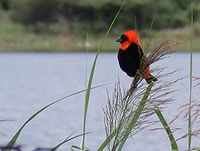 |
Director of the Edward Grey Institute of Field Ornithology Ornithology Ornithology is a branch of zoology that concerns the study of birds. Several aspects of ornithology differ from related disciplines, due partly to the high visibility and the aesthetic appeal of birds... and convert who wrote Evolutionary Theory and Christian Belief in 1957. As he is in part known for his study of the genus Euplectes a Black-winged Red Bishop Black-winged Red Bishop The Black-winged Red Bishop is a resident breeding bird species in tropical Africa from Senegal to Sudan and south to Angola and Tanzania.... is pictured. |
| Charles Coulson Charles Coulson Charles Alfred Coulson FRS was an applied mathematician, theoretical chemist and religious author.His major scientific work was as a pioneer of the application of the quantum theory of valency to problems of molecular structure, dynamics and reactivity... (1910–1974) |
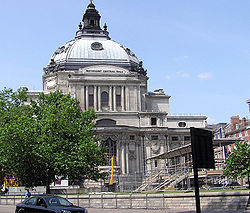 |
Methodist who wrote Science and Christian Belief in 1955. In 1970 he won the Davy Medal Davy Medal The Davy Medal is awarded by the Royal Society of London "for an outstandingly important recent discovery in any branch of chemistry". Named after Humphry Davy, the medal is awarded with a gift of £1000. The medal was first awarded in 1877 to Robert Wilhelm Bunsen and Gustav Robert Kirchhoff "for... . |
| Theodosius Dobzhansky Theodosius Dobzhansky Theodosius Grygorovych Dobzhansky ForMemRS was a prominent geneticist and evolutionary biologist, and a central figure in the field of evolutionary biology for his work in shaping the unifying modern evolutionary synthesis... (1900–1975) |
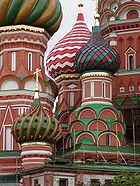 |
Russian Orthodox Russian Orthodox Church The Russian Orthodox Church or, alternatively, the Moscow Patriarchate The ROC is often said to be the largest of the Eastern Orthodox churches in the world; including all the autocephalous churches under its umbrella, its adherents number over 150 million worldwide—about half of the 300 million... geneticist who criticized young Earth creationism in an essay, "Nothing in Biology Makes Sense Except in the Light of Evolution Nothing in Biology Makes Sense Except in the Light of Evolution "Nothing in Biology Makes Sense Except in the Light of Evolution" is a 1973 essay by the evolutionary biologist and Russian Orthodox Christian Theodosius Dobzhansky, criticising anti-evolution creationism and espousing theistic evolution... ," and argued that science and faith did not conflict. |
| Michael Polanyi Michael Polanyi Michael Polanyi, FRS was a Hungarian–British polymath, who made important theoretical contributions to physical chemistry, economics, and the theory of knowledge... (1891–1976) |
.jpg) |
He was born Jewish, but became a Tolstoyan Tolstoyan The Tolstoyan movement is a social movement based on the philosophical and religious views of Russian novelist Leo Tolstoy . Tolstoy's views were formed by rigorous study of the ministry of Jesus, particularly the Sermon on the Mount.... and was also married in a Roman Catholic church. In 1946 he wrote Science, Faith, and Society ISBN 0-226-67290-5 A chair for him was created at the University of Manchester University of Manchester The University of Manchester is a public research university located in Manchester, United Kingdom. It is a "red brick" university and a member of the Russell Group of research-intensive British universities and the N8 Group... , hence an old portrait of part of the University is pictured. |
| Henry Eyring Henry Eyring Henry Eyring was a Mexican-born American theoretical chemist whose primary contribution was in the study of chemical reaction rates and intermediates.... (1901–1981) |
 |
American chemist known for developing the Eyring equation Eyring equation The Eyring equation also known as Eyring–Polanyi equation in chemical kinetics relates the reaction rate to temperature. It was developed almost simultaneously in 1935 by Henry Eyring, M.G. Evans and Michael Polanyi... . Also a Latter-Day Saint whose interactions with LDS President Joseph Fielding Smith Joseph Fielding Smith Joseph Fielding Smith, Jr. was the tenth president of The Church of Jesus Christ of Latter-day Saints from 1970 until his death. He was the son of Joseph F. Smith, who was the sixth president of the LDS Church... on science and faith are a part of LDS history. |
| William G. Pollard William G. Pollard William Grosvenor Pollard was a physicist and an Episcopal priest. He started his career as a professor of physics in 1936 at University of Tennessee. In 1946 he championed the organization of the Oak Ridge Institute of Nuclear Studies . He was its executive director until 1974. He was ordained... (1911–1989) |
 |
Anglican priest who wrote Physicist and Christian Physicist and Christian Physicist and Christian: A dialogue between the communities is a book by William G. Pollard. Much of the attention given to the book such as its review in Time magazine has been attributed to the fact that Pollard was not only a well-respected physicist but also an Anglican priest... . In addition he worked on the Manhattan Project Manhattan Project The Manhattan Project was a research and development program, led by the United States with participation from the United Kingdom and Canada, that produced the first atomic bomb during World War II. From 1942 to 1946, the project was under the direction of Major General Leslie Groves of the US Army... and for years served as the executive director of Oak Ridge Institute of Nuclear Studies Oak Ridge Associated Universities Oak Ridge Associated Universities is a consortium of American and British universities headquartered in Oak Ridge, Tennessee, with an office in Washington, D.C., and staff at several other locations across the country.- History :... . |
| Aldert van der Ziel Aldert van der Ziel Prof. Dr. Aldert van der Ziel, , was a Dutch physicist who studied electronic noise processes in materials such as semiconductors and metals.-Biography:... (1910–1991) |
He researched Flicker noise Flicker noise Flicker noise is a type of electronic noise with a 1/ƒ, or pink power density spectrum. It is therefore often referred to as 1/ƒ noise or pink noise, though these terms have wider definitions... and has the Institute of Electrical and Electronics Engineers Institute of Electrical and Electronics Engineers The Institute of Electrical and Electronics Engineers is a non-profit professional association headquartered in New York City that is dedicated to advancing technological innovation and excellence... named an award for him. The IEEE corporate office is pictured. He also was a conservative Lutheran who wrote The Natural Sciences and the Christian Message. |
|
| Carlos Chagas Filho Carlos Chagas Filho Carlos Chagas Filho was a Brazilian physician, biologist and scientist active in the field of neuroscience. He was internationally renowned for his investigations on the neural mechanisms underlying the phenomenon of electrogenesis by the electroplaques of electric fishes... (1910–2000) |
 |
Neuroscientist who headed the Pontifical Academy of Sciences Pontifical Academy of Sciences The Pontifical Academy of Sciences is a scientific academy of the Vatican, founded in 1936 by Pope Pius XI. It is placed under the protection of the reigning Supreme Pontiff. Its aim is to promote the progress of the mathematical, physical and natural sciences and the study of related... for 16 years. He studied the Shroud of Turin Shroud of Turin The Shroud of Turin or Turin Shroud is a linen cloth bearing the image of a man who appears to have suffered physical trauma in a manner consistent with crucifixion. It is kept in the royal chapel of the Cathedral of Saint John the Baptist in Turin, northern Italy. The image on the shroud is... and his "the Origin of the Universe", "the Origin of Life", and "the Origin of Man" involved an understanding between Catholicism and Science. He was from Rio de Janeiro Rio de Janeiro Rio de Janeiro , commonly referred to simply as Rio, is the capital city of the State of Rio de Janeiro, the second largest city of Brazil, and the third largest metropolitan area and agglomeration in South America, boasting approximately 6.3 million people within the city proper, making it the 6th... , hence the well known Christ the Redeemer Christ the Redeemer (statue) Christ the Redeemer is a statue of Jesus Christ in Rio de Janeiro, Brazil; considered the largest Art Deco statue in the world and the 5th largest statue of Jesus in the world. It is tall, including its pedestal, and wide. It weighs 635 tonnes , and is located at the peak of the Corcovado... statue is pictured. |
2001–today (21st century)
Interest in the relationship between science and religion has increased in recent decades due to continued controversies and recognition from awards like the Templeton Prize.| Name | Image | Reason for inclusion |
|---|---|---|
| Sir Robert Boyd (1922–2004) | 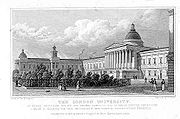 |
A pioneer in British space science who was Vice President of the Royal Astronomical Society Royal Astronomical Society The Royal Astronomical Society is a learned society that began as the Astronomical Society of London in 1820 to support astronomical research . It became the Royal Astronomical Society in 1831 on receiving its Royal Charter from William IV... . He lectured on faith being a founder of the "Research Scientists' Christian Fellowship" and an important member of its predecessor Christians in Science Christians in Science Christians in Science is a British organization of scientists, philosophers, theologians, ministers, teachers, and science students, predominantly evangelical Christians, concerned with the dialogue between Christianity and science... . He was connected to the University College London University College London University College London is a public research university located in London, United Kingdom and the oldest and largest constituent college of the federal University of London... which is shown here in an old drawing. |
| Richard Smalley Richard Smalley Richard Errett Smalley was the Gene and Norman Hackerman Professor of Chemistry and a Professor of Physics and Astronomy at Rice University, in Houston, Texas... (1943–2005) |
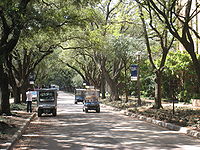 |
A Nobel Laureate in Chemistry known for buckyballs. In his last years he renewed an interest in Christianity and supported Intelligent design Intelligent design Intelligent design is the proposition that "certain features of the universe and of living things are best explained by an intelligent cause, not an undirected process such as natural selection." It is a form of creationism and a contemporary adaptation of the traditional teleological argument for... . He taught at Rice University Rice University William Marsh Rice University, commonly referred to as Rice University or Rice, is a private research university located on a heavily wooded campus in Houston, Texas, United States... , part of which is pictured. |
| Arthur Peacocke Arthur Peacocke The Reverend Canon Arthur Robert Peacocke MBE was a British theologian and biochemist.-Biography:Arthur Robert Peacocke was born at Watford in on 29 November 1924... (1924–2006) |
 |
Anglican priest and biochemist Biochemist Biochemists are scientists who are trained in biochemistry. Typical biochemists study chemical processes and chemical transformations in living organisms. The prefix of "bio" in "biochemist" can be understood as a fusion of "biological chemist."-Role:... , his ideas may have influenced Anglican and Lutheran Lutheranism Lutheranism is a major branch of Western Christianity that identifies with the theology of Martin Luther, a German reformer. Luther's efforts to reform the theology and practice of the church launched the Protestant Reformation... views of evolution. Winner of the 2001 Templeton Prize Templeton Prize The Templeton Prize is an annual award presented by the Templeton Foundation. Established in 1972, it is awarded to a living person who, in the estimation of the judges, "has made an exceptional contribution to affirming life's spiritual dimension, whether through insight, discovery, or practical... . He was a Dean at Clare College, Cambridge Clare College, Cambridge Clare College is a constituent college of the University of Cambridge in Cambridge, England.The college was founded in 1326, making it the second-oldest surviving college of the University after Peterhouse. Clare is famous for its chapel choir and for its gardens on "the Backs"... , which is pictured. |
| C. F. von Weizsäcker Carl Friedrich von Weizsäcker Carl Friedrich Freiherr von Weizsäcker was a German physicist and philosopher. He was the longest-living member of the research team which performed nuclear research in Germany during the Second World War, under Werner Heisenberg's leadership... (1912–2007) |
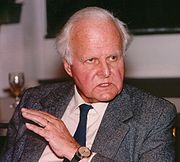 |
German nuclear physicist who is the co-discoverer of the Bethe-Weizsäcker formula. His The Relevance of Science: Creation and Cosmogony concerned Christian and moral impacts of science. He headed the Max Planck Society Max Planck Society The Max Planck Society for the Advancement of Science is a formally independent non-governmental and non-profit association of German research institutes publicly funded by the federal and the 16 state governments of Germany.... from 1970 to 1980. After that he retired to be a Christian pacifist. |
| Stanley Jaki Stanley Jaki Stanley L. Jaki, OSB was a Benedictine priest and Distinguished Professor of Physics at Seton Hall University, New Jersey since 1975... (1924–2009) |
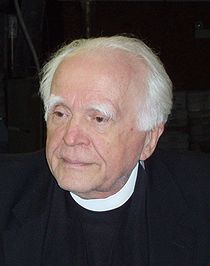 |
Benedictine Benedictine Benedictine refers to the spirituality and consecrated life in accordance with the Rule of St Benedict, written by Benedict of Nursia in the sixth century for the cenobitic communities he founded in central Italy. The most notable of these is Monte Cassino, the first monastery founded by Benedict... priest and Distinguished Professor of Physics at Seton Hall University, New Jersey, who won a Templeton Prize and advocated the idea modern science could only have arisen in a Christian society. |
| Allan Sandage Allan Sandage Allan Rex Sandage was an American astronomer. He was Staff Member Emeritus with the Carnegie Observatories in Pasadena, California. He is best known for determining the first reasonably accurate value for the Hubble constant and the age of the universe.-Career:Sandage was one of the most... (1926–2010) |
 |
An astronomer who did not really study Christianity until after age forty. He wrote the article A Scientist Reflects on Religious Belief and made discoveries concerning the Cigar Galaxy which is pictured. |
Living
This section concerns significant Christian thinkers in science who are alive today. Those who lead organizations of Christians in science or who write works concerning how Christians of today respond to science.| Name | Image | Reason for inclusion |
|---|---|---|
| Charles Hard Townes Charles Hard Townes Charles Hard Townes is an American Nobel Prize-winning physicist and educator. Townes is known for his work on the theory and application of the maser, on which he got the fundamental patent, and other work in quantum electronics connected with both maser and laser devices. He shared the Nobel... (born 1915) |
In 1964 he won the Nobel Prize in Physics Nobel Prize in Physics The Nobel Prize in Physics is awarded once a year by the Royal Swedish Academy of Sciences. It is one of the five Nobel Prizes established by the will of Alfred Nobel in 1895 and awarded since 1901; the others are the Nobel Prize in Chemistry, Nobel Prize in Literature, Nobel Peace Prize, and... and in 1966 he wrote The Convergence of Science and Religion. The picture is of Townes with Dr. Roderic Pettigrew, Townes is on the right. |
|
| Ian Barbour Ian Barbour Ian Graeme Barbour, born 5 October 1923, is an American scholar on the relationship between science and religion. According to the Public Broadcasting Service his mid-1960s Issues in Science and Religion "has been credited with literally creating the contemporary field of science and religion."In... (born 1923) |
 |
Physicist who wrote Christianity and the Scientists in 1960, and When Science Meets Religion ISBN 0-06-060381-X in 2000. For years he taught at Carleton College Carleton College Carleton College is an independent non-sectarian, coeducational, liberal arts college in Northfield, Minnesota, USA. The college enrolls 1,958 undergraduate students, and employs 198 full-time faculty members. In 2012 U.S... , hence their observatory is pictured. |
| Freeman Dyson Freeman Dyson Freeman John Dyson FRS is a British-born American theoretical physicist and mathematician, famous for his work in quantum field theory, solid-state physics, astronomy and nuclear engineering. Dyson is a member of the Board of Sponsors of the Bulletin of the Atomic Scientists... (born 1923) |
 |
He has won the Lorentz Medal Lorentz Medal Lorentz Medal is a prize awarded every four years by the Royal Netherlands Academy of Arts and Sciences. It was established in 1925 on the occasion of the 50th anniversary of the doctorate of Hendrik Lorentz. This solid gold medal is given for important contributions to theoretical physics, though... , the Max Planck Medal Max Planck medal The Max Planck medal is an award for extraordinary achievements in theoretical physics. It is awarded annually by the Deutsche Physikalische Gesellschaft , the world's largest organization of physicists.-List of recipients:... , and the Lewis Thomas Prize Lewis Thomas Prize The Lewis Thomas Prize for Writing about Science, named for its first recipient, Lewis Thomas, is an annual literary prize awarded by Rockefeller University to scientists deemed to have accomplished a significant literary achievement: it "recognizes scientists as poets"... . He also ranked 25th in The 2005 Global Intellectuals Poll The 2005 Global Intellectuals Poll The Top 100 Public Intellectuals Poll was conducted in November 2005 and June 2008 by Prospect Magazine and Foreign Policy on the basis of responding readers' ballot... . He has won the Templeton Prize and delivered one of the Gifford Lectures Gifford Lectures The Gifford Lectures were established by the will of Adam Lord Gifford . They were established to "promote and diffuse the study of Natural Theology in the widest sense of the term — in other words, the knowledge of God." The term natural theology as used by Gifford means theology supported... . Although Dyson says "I am myself a Christian", he also adds "I am a practicing Christian but not a believing Christian. To me, to worship God means to recognize that mind and intelligence are woven into the fabric of our universe in a way that altogether surpasses our comprehension." |
| Antonino Zichichi Antonino Zichichi Antonino Zichichi is an Italian physicist who has worked in the field of nuclear physics.-Biography:Zichichi was born in Trapani, Sicily, in 1929. He has collaborated to several important discoveries in the field of subnuclear physics and has worked in some of the most important research... (born 1929) |
Italian nuclear physicist and former President of the Istituto Nazionale di Fisica Nucleare Istituto Nazionale di Fisica Nucleare The Istituto Nazionale di Fisica Nucleare is the coordinating institution for nuclear, particle and astroparticle physics in Italy. It was founded on the 8th of August 1951, to further the nuclear physics research tradition initiated by Enrico Fermi in Rome, in the 1930s... . He has worked with the Vatican on relations between the Church and Science. |
|
| John Polkinghorne John Polkinghorne John Charlton Polkinghorne KBE FRS is an English theoretical physicist, theologian, writer, and Anglican priest. He was professor of Mathematical physics at the University of Cambridge from 1968 to 1979, when he resigned his chair to study for the priesthood, becoming an ordained Anglican priest... (born 1930) |
 |
British particle physicist and Anglican Anglicanism Anglicanism is a tradition within Christianity comprising churches with historical connections to the Church of England or similar beliefs, worship and church structures. The word Anglican originates in ecclesia anglicana, a medieval Latin phrase dating to at least 1246 that means the English... priest who wrote Science and the Trinity (2004) ISBN 0-300-10445-6. Winner of the 2002 Templeton Prize. |
| Owen Gingerich Owen Gingerich Dr. Owen Jay Gingerich is a former Research Professor of Astronomy and of the History of Science at Harvard University, and a senior astronomer emeritus at the Smithsonian Astrophysical Observatory... (born 1930) |
Mennonite Mennonite The Mennonites are a group of Christian Anabaptist denominations named after the Frisian Menno Simons , who, through his writings, articulated and thereby formalized the teachings of earlier Swiss founders... astronomer who went to Goshen College Goshen College Goshen College, is a private Mennonite liberal arts college in Goshen, Indiana, USA with an enrollment of around 1,000 students. The college is accredited by North Central Association of Colleges and Schools and is a member of the Council for Christian Colleges and Universities... and Harvard. An old picture of Goshen is shown. Mr. Gingerich has written about people of faith in science history. |
|
| John T. Houghton John T. Houghton As co-chair of the IPCC, he defends the IPCC process, in particular against charges of failure to consider non-CO2 explanations of climate change. In evidence to, the Select Committee on Science and Technology in 2000 he said:... (born 1931) |
 |
He is the co-chair of the Intergovernmental Panel on Climate Change Intergovernmental Panel on Climate Change The Intergovernmental Panel on Climate Change is a scientific intergovernmental body which provides comprehensive assessments of current scientific, technical and socio-economic information worldwide about the risk of climate change caused by human activity, its potential environmental and... and won a gold medal from the Royal Astronomical Society Royal Astronomical Society The Royal Astronomical Society is a learned society that began as the Astronomical Society of London in 1820 to support astronomical research . It became the Royal Astronomical Society in 1831 on receiving its Royal Charter from William IV... . He's also former Vice President of Christians in Science. |
| R. J. Berry (born 1934) |
 |
He is a former president of both the Linnean Society of London Linnean Society of London The Linnean Society of London is the world's premier society for the study and dissemination of taxonomy and natural history. It publishes a zoological journal, as well as botanical and biological journals... and the Christians in Science group. He also wrote God and the Biologist: Personal Exploration of Science and Faith (Apollos 1996) ISBN 0-85111-446-6 As he taught at University College London University College London University College London is a public research university located in London, United Kingdom and the oldest and largest constituent college of the federal University of London... for over 20 years its main building is pictured. |
| Michał Heller (born 1936) |
He is a Catholic priest, a member of the Pontifical Academy of Theology, a founding member of the International Society for Science and Religion. He also is a mathematical physicist who has written articles on relativistic physics and Noncommutative geometry Noncommutative geometry Noncommutative geometry is a branch of mathematics concerned with geometric approach to noncommutative algebras, and with construction of spaces which are locally presented by noncommutative algebras of functions... . His cross-disciplinary book Creative Tension: Essays on Science and Religion came out in 2003. For this work he won a Templeton Prize. He teaches at Kraków Kraków Kraków also Krakow, or Cracow , is the second largest and one of the oldest cities in Poland. Situated on the Vistula River in the Lesser Poland region, the city dates back to the 7th century. Kraków has traditionally been one of the leading centres of Polish academic, cultural, and artistic life... , hence the picture of a Basilica from the city. |
|
| Ghillean Prance Ghillean Prance Sir Ghillean Tolmie Prance FRS VMH is a prominent British botanist and ecologist.He has published extensively on the taxonomy of families such as Chrysobalanaceae and Lecythidaceae, but he perhaps drew more attention in documenting the pollination ecology of Victoria amazonica... (born 1937) |
 |
Noted botanist involved in the Eden Project Eden Project The Eden Project is a visitor attraction in Cornwall in the United Kingdom, including the world's largest greenhouse. Inside the artificial biomes are plants that are collected from all around the world.... , which is pictured. He is also the current President of Christians in Science Christians in Science Christians in Science is a British organization of scientists, philosophers, theologians, ministers, teachers, and science students, predominantly evangelical Christians, concerned with the dialogue between Christianity and science... . |
| Donald Knuth Donald Knuth Donald Ervin Knuth is a computer scientist and Professor Emeritus at Stanford University.He is the author of the seminal multi-volume work The Art of Computer Programming. Knuth has been called the "father" of the analysis of algorithms... (born 1938) |
 |
(Lutheran) The Art of Computer Programming The Art of Computer Programming The Art of Computer Programming is a comprehensive monograph written by Donald Knuth that covers many kinds of programming algorithms and their analysis.... and 3:16 Bible Texts Illuminated (1991), ISBN 0-89579-252-4. |
| Eric Priest Eric Priest Eric Priest, FRSE, FRS, holds the Gregory Chair of Mathematics and is a Bishop Wardlaw Professor at St Andrews University.... (born 1943) |
 |
An authority on Solar Magnetohydrodynamics who won the George Ellery Hale Prize George Ellery Hale Prize The George Ellery Hale Prize, or Hale Prize, is awarded annually by the Solar Physics Division of the American Astronomical Society for outstanding contributions over an extended period of time to the field of solar astronomy. The prize is named in memory of George Ellery Hale.Past winners of the... among others. He has spoken on Christianity and Science at the University of St Andrews University of St Andrews The University of St Andrews, informally referred to as "St Andrews", is the oldest university in Scotland and the third oldest in the English-speaking world after Oxford and Cambridge. The university is situated in the town of St Andrews, Fife, on the east coast of Scotland. It was founded between... and is a member of the Faraday Institute Faraday Institute The Faraday Institute for Science and Religion is an interdisciplinary academic research institute based at St Edmund's College, Cambridge, England... . An image from St. Andrews is shown. He is also interested in prayer, meditation, and Christian psychology. |
| Christopher Isham Christopher Isham Christopher Isham is a theoretical physicist at Imperial College London. His main research interests are quantum gravity and foundational studies in quantum theory. He was the inventor of an approach to temporal quantum logic called the HPO formalism, and has worked on loop quantum gravity and... (born 1944) |
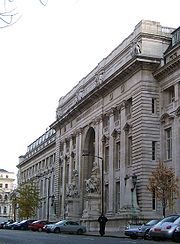 |
Theoretical physicist who developed HPO formalism HPO formalism The History Projection Operator formalism is an approach to temporal quantum logic developed by Chris Isham. It deals with the logical structure of quantum mechanical propositions asserted at different points in time.- Introduction :... . He teaches at Imperial College London Imperial College London Imperial College London is a public research university located in London, United Kingdom, specialising in science, engineering, business and medicine... , part of which is pictured to the side. In addition to being a physicist, he is a philosopher and theologian. |
| Henry F. Schaefer, III Henry F. Schaefer, III Henry "Fritz" Schaefer III is a computational and theoretical chemist. He is the author of a large number of scientific publications, and was the 6th most cited chemist from 1981 to 1997 and the Graham Perdue Professor of Chemistry and Director of the Center for Computational Chemistry at the... (born 1944) |
 |
He wrote Science and Christianity: Conflict or Coherence? ISBN 0-9742975-0-X and is a signatory of A Scientific Dissent From Darwinism A Scientific Dissent From Darwinism A Scientific Dissent from Darwinism is a statement issued in 2001 by the Discovery Institute, a conservative non-profit public policy think tank based in Seattle, Washington, USA, best known for its advocacy of intelligent design.The statement expresses skepticism about the ability of random... . He was awarded the American Chemical Society Award in Pure Chemistry in 1979. |
| Robert T. Bakker Robert T. Bakker Robert T. Bakker is an American paleontologist who helped reshape modern theories about dinosaurs, particularly by adding support to the theory that some dinosaurs were endothermic... (born 1945) |
Paleontologist who was a figure in the "dinosaur Renaissance Dinosaur renaissance The dinosaur renaissance was a small-scale scientific revolution that started in the late 1960s, and led to renewed academic and popular interest in dinosaurs... " and known for the theory some dinosaurs were Warm-blooded Warm-blooded The term warm-blooded is a colloquial term to describe animal species which have a relatively higher blood temperature, and maintain thermal homeostasis primarily through internal metabolic processes... . He is also a Pentecostal preacher who advocates theistic evolution Theistic evolution Theistic evolution or evolutionary creation is a concept that asserts that classical religious teachings about God are compatible with the modern scientific understanding about biological evolution... and has written on religion. |
|
| Kenneth R. Miller Kenneth R. Miller Kenneth Raymond Miller is a biology professor at Brown University. Miller, who is Roman Catholic, is particularly known for his opposition to creationism, including the intelligent design movement... (born 1948) |
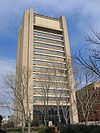 |
Biology professor at Brown University Brown University Brown University is a private, Ivy League university located in Providence, Rhode Island, United States. Founded in 1764 prior to American independence from the British Empire as the College in the English Colony of Rhode Island and Providence Plantations early in the reign of King George III ,... who wrote Finding Darwin's God ISBN 0-06-093049-7, The picture is of Brown's Science Library. |
| Francis Collins Francis Collins (geneticist) Francis Sellers Collins , is an American physician-geneticist, noted for his discoveries of disease genes and his leadership of the Human Genome Project . He currently serves as Director of the National Institutes of Health in Bethesda, Maryland. Prior to being appointed Director, he founded and... (born 1950) |
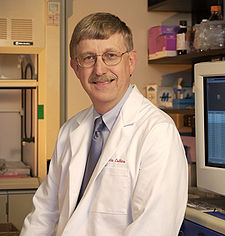 |
He is the current director of the National Institutes of Health National Institutes of Health The National Institutes of Health are an agency of the United States Department of Health and Human Services and are the primary agency of the United States government responsible for biomedical and health-related research. Its science and engineering counterpart is the National Science Foundation... and former director of the US National Human Genome Research Institute National Human Genome Research Institute The National Human Genome Research Institute is a division of the National Institutes of Health, located in Bethesda, Maryland.NHGRI began as the National Center for Human Genome Research , which was established in 1989 to carry out the role of the NIH in the International Human Genome Project... . He has also written on religious matters in articles and in Faith and the Human Genome he states the importance to him of "the literal and historical Resurrection of Jesus Christ from the dead, which is the cornerstone of what I believe." He wrote the book The Language of God: A Scientist Presents Evidence for Belief. |
| Simon C. Morris Simon Conway Morris Simon Conway Morris FRS is an English paleontologist made known by his detailed and careful study of the Burgess Shale fossils, an exploit celebrated in Wonderful Life by Stephen Jay Gould... (born 1951) |
 |
British paleontologist who made his reputation through study of the Burgess Shale Burgess Shale The Burgess Shale Formation, located in the Canadian Rockies of British Columbia, is one of the world's most celebrated fossil fields, and the best of its kind. It is famous for the exceptional preservation of the soft parts of its fossils... fossils, one of which is pictured. He was the co-winner of a Charles Doolittle Walcott Medal Charles Doolittle Walcott Medal Charles Doolittle Walcott Medal is an award presented by the National Academy of Sciences every five years to promote research and study in the fields of Precambrian and Cambrian life and history. The medal was established and endowed in 1934 by the Walcott Fund, a gift of Mary Vaux Walcott, in... and also won a Lyell Medal Lyell Medal The Lyell Medal is a prestigious annual scientific medal given by the Geological Society of London, equal in status to the Murchison Medal, awarded on the basis of research to an Earth Scientist of exceptional quality... . He is active in the Faraday Institute Faraday Institute The Faraday Institute for Science and Religion is an interdisciplinary academic research institute based at St Edmund's College, Cambridge, England... for study of science and religion and is also noted on discussions concerning the idea of theistic evolution Theistic evolution Theistic evolution or evolutionary creation is a concept that asserts that classical religious teachings about God are compatible with the modern scientific understanding about biological evolution... . |
| John D. Barrow John D. Barrow -External links:****** The Forum-Publications available on the Internet:************... (born 1952) |
 |
English cosmologist who did notable writing on the implications of the Anthropic principle Anthropic principle In astrophysics and cosmology, the anthropic principle is the philosophical argument that observations of the physical Universe must be compatible with the conscious life that observes it. Some proponents of the argument reason that it explains why the Universe has the age and the fundamental... . He is a United Reformed Church United Reformed Church The United Reformed Church is a Christian church in the United Kingdom. It has approximately 68,000 members in 1,500 congregations with some 700 ministers.-Origins and history:... member and Christian deist. He won the Templeton Prize Templeton Prize The Templeton Prize is an annual award presented by the Templeton Foundation. Established in 1972, it is awarded to a living person who, in the estimation of the judges, "has made an exceptional contribution to affirming life's spiritual dimension, whether through insight, discovery, or practical... in 2006. He once held the position of Gresham Professor of Astronomy Gresham Professor of Astronomy The Professor of Astronomy at Gresham College, London, gives free educational lectures to the general public. The college was founded for this purpose in 1596 / 7, when it appointed seven professors; this has since increased to eight and in addition the college now has visiting professors.The... , so their crest is pictured. |
| Denis Alexander Denis Alexander Dr. Denis Alexander is the director of the Faraday Institute for Science and Religion at St Edmund's College, Cambridge, a molecular biologist and an author on science and religion. He is also an editor of Science and Christian Belief. He is an evangelical Christian.-Scientific work:Alexander was... (born ????) |
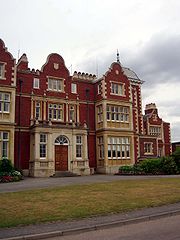 |
Director of the Faraday Institute Faraday Institute The Faraday Institute for Science and Religion is an interdisciplinary academic research institute based at St Edmund's College, Cambridge, England... and author of Rebuilding the Matrix – Science and Faith in the 21st Century. He also supervises a research group in cancer and immunology at the Babraham Institute Babraham Institute The Babraham Institute, set in an extensive parkland estate just south of Cambridge, is an independent charitable life sciences institute involved in biomedical research. The aim of this research is to discover the molecular mechanisms that underlie normal cellular processes and functions, and how... , hence Babraham hall is pictured. |
| Stephen Barr Stephen Barr Stephen M. Barr is a professor of Particle Physics at the Bartol Research Institute and the Department of Physics and Astronomy at the University of Delaware. His research interests include Elementary Particle Theory, Supersymmetric Grand Unified Theories, and Cosmology. He has authored over 120... (born ????) |
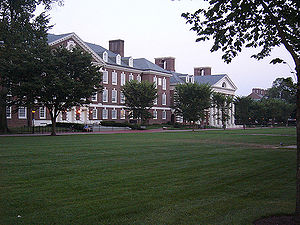 |
Physicist who worked at Brookhaven National Laboratory Brookhaven National Laboratory Brookhaven National Laboratory , is a United States national laboratory located in Upton, New York on Long Island, and was formally established in 1947 at the site of Camp Upton, a former U.S. Army base... and contributed papers to Physical Review Physical Review Physical Review is an American scientific journal founded in 1893 by Edward Nichols. It publishes original research and scientific and literature reviews on all aspects of physics. It is published by the American Physical Society. The journal is in its third series, and is split in several... as well as Physics Today Physics Today Physics Today, created in 1948, is the membership journal of the American Institute of Physics. It is provided to 130,000 members of twelve physics societies, including the American Physical Society... . He also is a Catholic who writes for First Things First Things First Things is an ecumenical journal focused on creating a "religiously informed public philosophy for the ordering of society". The journal is inter-denominational and inter-religious, representing a broad intellectual tradition of Christian and Jewish critique of contemporary society... and wrote Modern Physics and Ancient Faith Modern Physics and Ancient Faith Modern Physics and Ancient Faith is a book by Stephen M. Barr, a physicist from the University of Delaware and frequent contributor to First Things. This book is "an extended attack" on what Barr calls scientific materialism. National Review says of the book: "[A] lucid and engaging survey of... . He teaches at the University of Delaware University of Delaware The university is organized into seven colleges:* College of Agriculture and Natural Resources* College of Arts and Sciences* Alfred Lerner College of Business and Economics* College of Earth, Ocean and Environment* College of Education and Human Development... , whose Wolf Hall is pictured. |
| Martin Nowak Martin Nowak Martin A. Nowak is Professor of Biology and Mathematics and Director of the Program for Evolutionary Dynamics at Harvard University.-Career:Martin Nowak studied biochemistry and mathematics at the University of Vienna, and earned his Ph. D. in 1989, working with Peter Schuster on quasi-species... (born 1965) |
 |
Evolutionary biologist and mathematician best known for evolutionary dynamics. He teaches at Harvard University Harvard University Harvard University is a private Ivy League university located in Cambridge, Massachusetts, United States, established in 1636 by the Massachusetts legislature. Harvard is the oldest institution of higher learning in the United States and the first corporation chartered in the country... , which is pictured in an old drawing. |
| John Lennox John Lennox John Carson Lennox is Professor of Mathematics at the University of Oxford, Fellow in Mathematics, Philosophy of Science and Pastoral Advisor at Green Templeton College of Oxford University... |
Mathematician and Pastoral adviser. His works include the mathematical The Theory of Infinite Soluble Groups and the religion-oriented God's Undertaker – Has Science buried God? He has also debated religion with Richard Dawkins Richard Dawkins Clinton Richard Dawkins, FRS, FRSL , known as Richard Dawkins, is a British ethologist, evolutionary biologist and author... . He teaches at Oxford, so an old map of it is pictured. |
|
| Jennifer Wiseman Jennifer Wiseman Jennifer J. Wiseman is an American astronomer. She received her bachelor's degree in physics from MIT and her Ph.D. in Astronomy from Harvard University in 1995. Wiseman discovered periodic comet 114P/Wiseman-Skiff while working as an undergraduate research assistant in 1987... |
She is Chief of the Laboratory for Exoplanets and Stellar Astrophysics at NASA Goddard Space Flight Center Goddard Space Flight Center The Goddard Space Flight Center is a major NASA space research laboratory established on May 1, 1959 as NASA's first space flight center. GSFC employs approximately 10,000 civil servants and contractors, and is located approximately northeast of Washington, D.C. in Greenbelt, Maryland, USA. GSFC,... . An aerial of the Center is shown. In addition she is a co-discoverer of 114P/Wiseman-Skiff 114P/Wiseman-Skiff 114P/Wiseman-Skiff is a periodic comet in our solar system.It was discovered by Jennifer Wiseman in January of 1987 on two photographic plates that had been taken on December 28, 1986, by Brian A. Skiff of Lowell Observatory... . In religion is a Fellow of the American Scientific Affiliation American Scientific Affiliation The American Scientific Affiliation is a Christian religious organization of scientists and people in science-related disciplines. The stated purpose is "to investigate any area relating Christian faith and science." The organization publishes a journal, Perspectives of Science and Christian Faith... and on June 16, 2010 became the new director for the American Association for the Advancement of Science American Association for the Advancement of Science The American Association for the Advancement of Science is an international non-profit organization with the stated goals of promoting cooperation among scientists, defending scientific freedom, encouraging scientific responsibility, and supporting scientific education and science outreach for the... 's Dialogue on Science, Ethics, and Religion. |
See also
- Issues in Science and ReligionIssues in Science and ReligionIssues in Science and Religion is a book by Ian Barbour. A biography provided by the John Templeton Foundation and published by PBS online states this book "has been credited with literally creating the contemporary field of science and religion."...
- List of Roman Catholic scientist-clerics
- List of Catholic scientists
- Lists of Christians
- List of Jesuit scientists
- Quakers in scienceQuakers in scienceThe Religious Society of Friends encouraged some values which may have been conducive to encouraging scientific talents. A theory suggested by David Hackett Fischer in his book Albion's Seed indicated early Quakers in the US preferred "practical study" to the more traditional studies of Greek or...
- List of Jewish scientists and philosophers
- List of Muslim scientists
- List of atheists (science and technology)
- List of science and religion scholars
- Conflict thesisConflict thesisThe conflict thesis proposes an intrinsic intellectual conflict between religion and science. The original historical usage of the term denoted that the historical record indicates religion’s perpetual opposition to science. Later uses of the term denote religion’s epistemological opposition to...
- Victoria InstituteVictoria InstituteThe Victoria Institute, or Philosophical Society of Great Britain, was founded in 1865, as a response to the publication of On the Origin of Species and Essays and Reviews. Its stated objective was to defend "the great truths revealed in Holy Scripture .....
External links
- Christianity And The Scientist by Ian G. Barbour
- Cambridge Christians in Science (CiS) group
- Christians in Science website
- Ian Ramsey Centre, Oxford
- The Society of Ordained Scientists-Mostly Church of EnglandChurch of EnglandThe Church of England is the officially established Christian church in England and the Mother Church of the worldwide Anglican Communion. The church considers itself within the tradition of Western Christianity and dates its formal establishment principally to the mission to England by St...
- "Science in Christian Perspective" The (ASA)
- Canadian Scientific and Christian Affiliation about page explaining why they exist
- The International Society for Science & Religion's founding members.(Of various faiths including Christianity)
- Association of Christians in the Mathematical Sciences
- Secular Humanism.org article on Science and Religion

